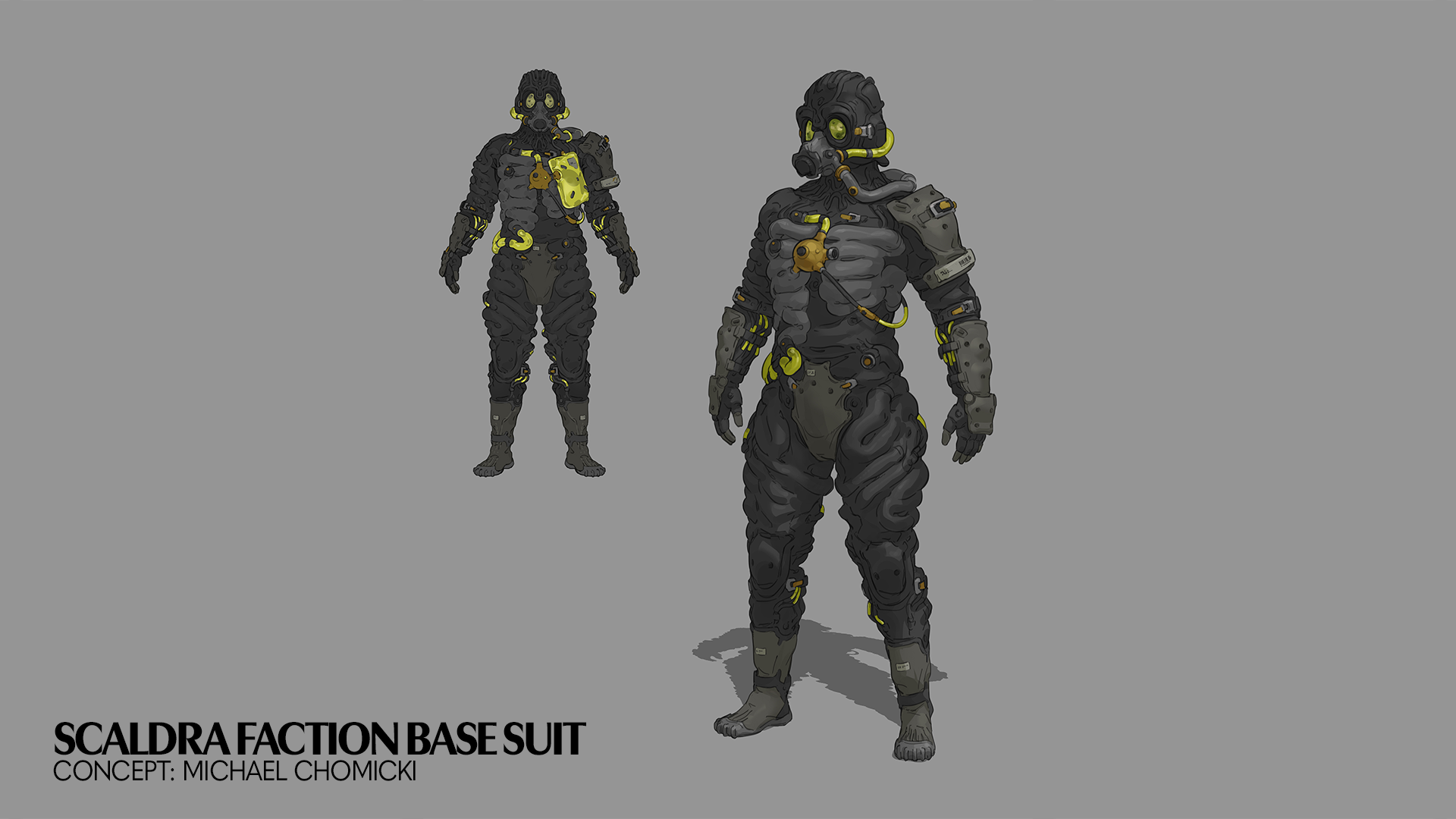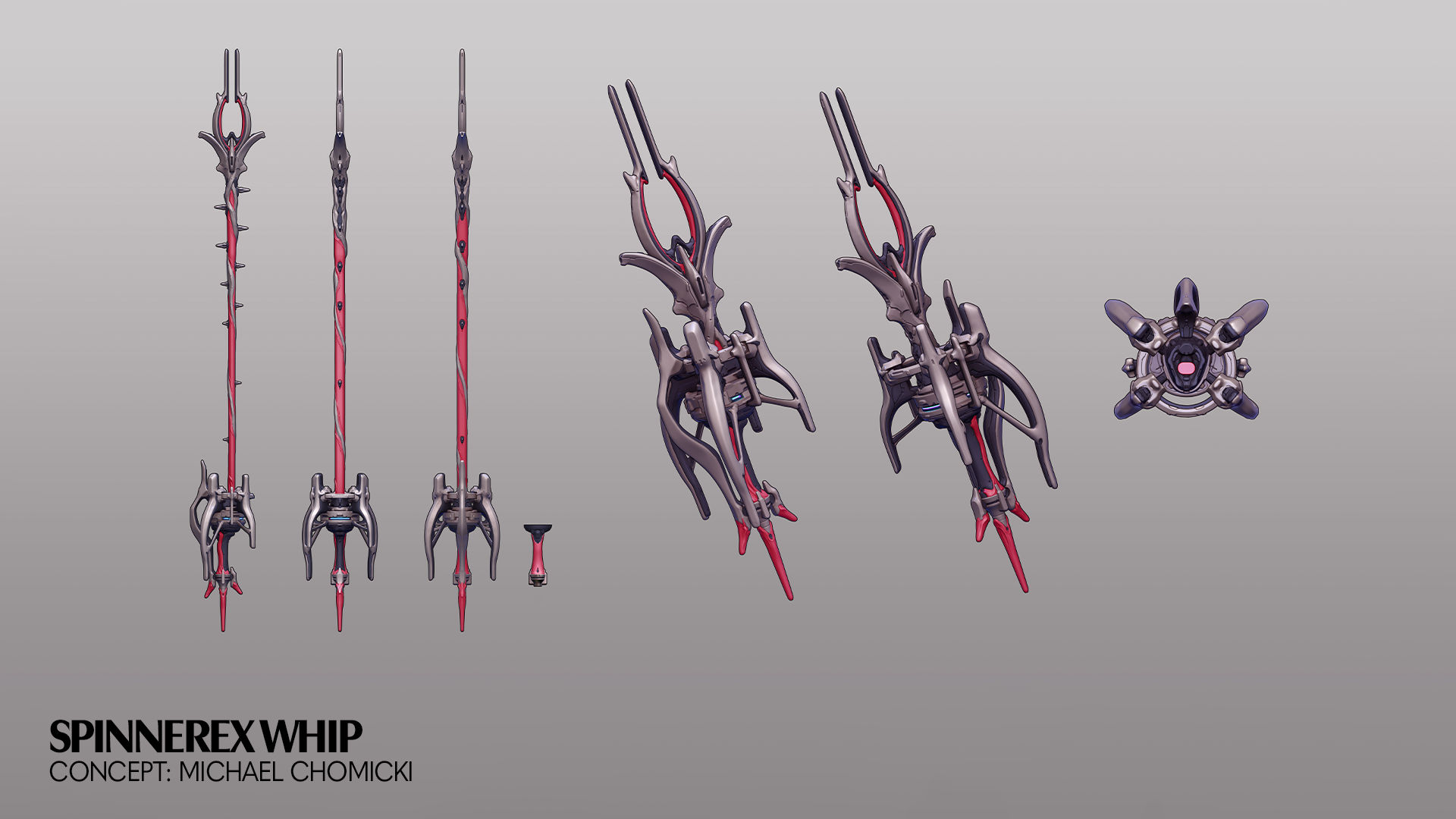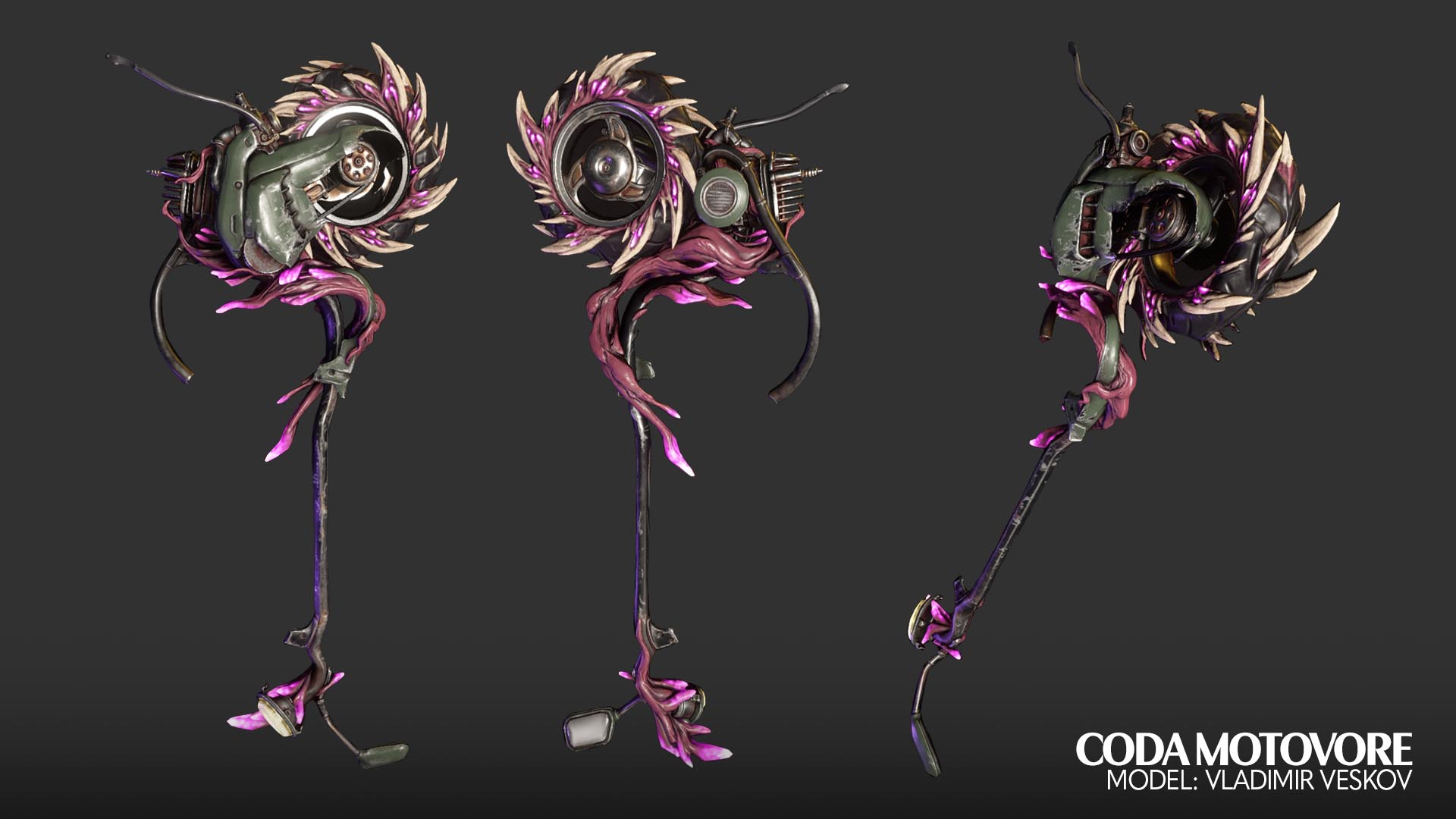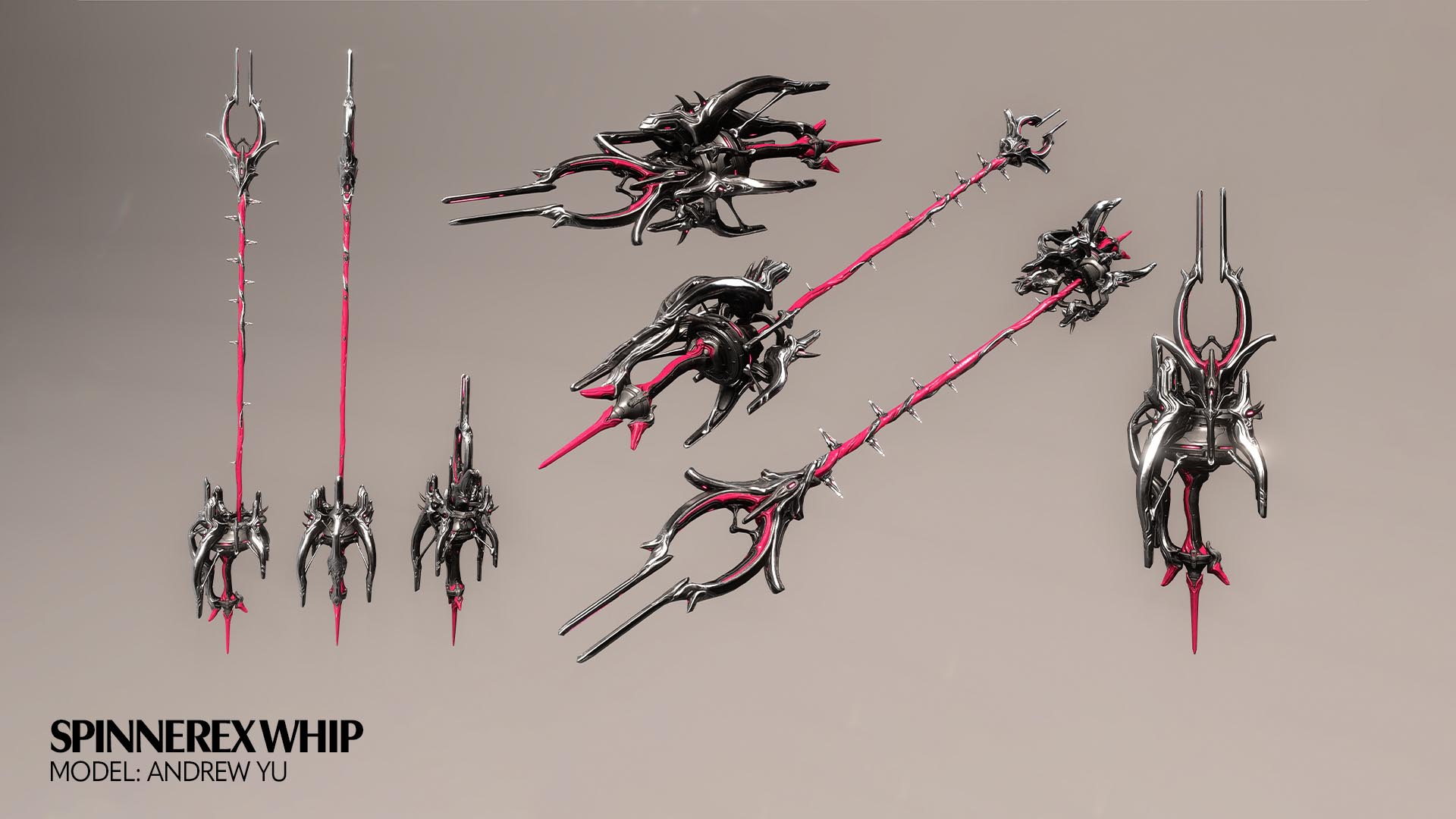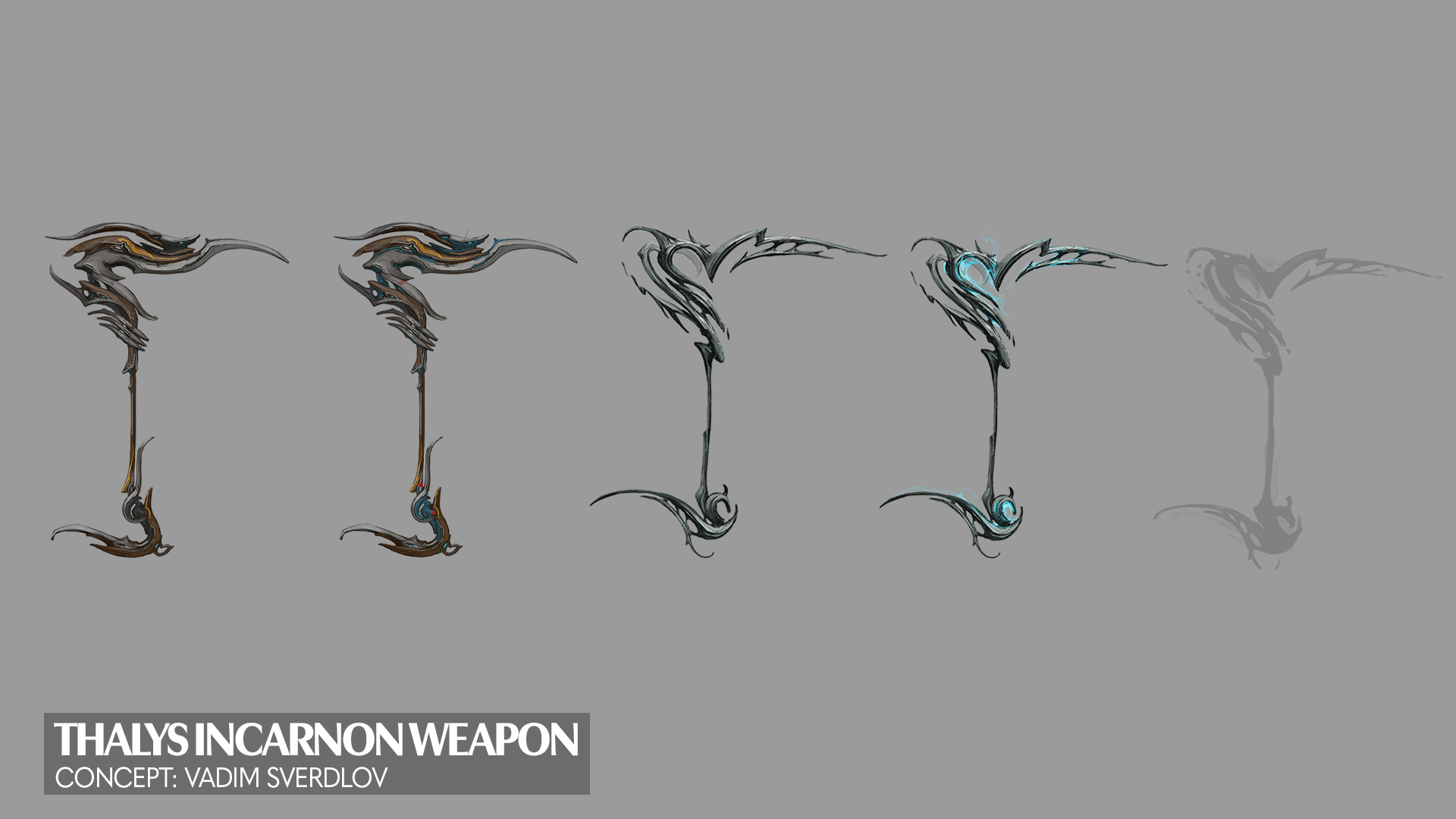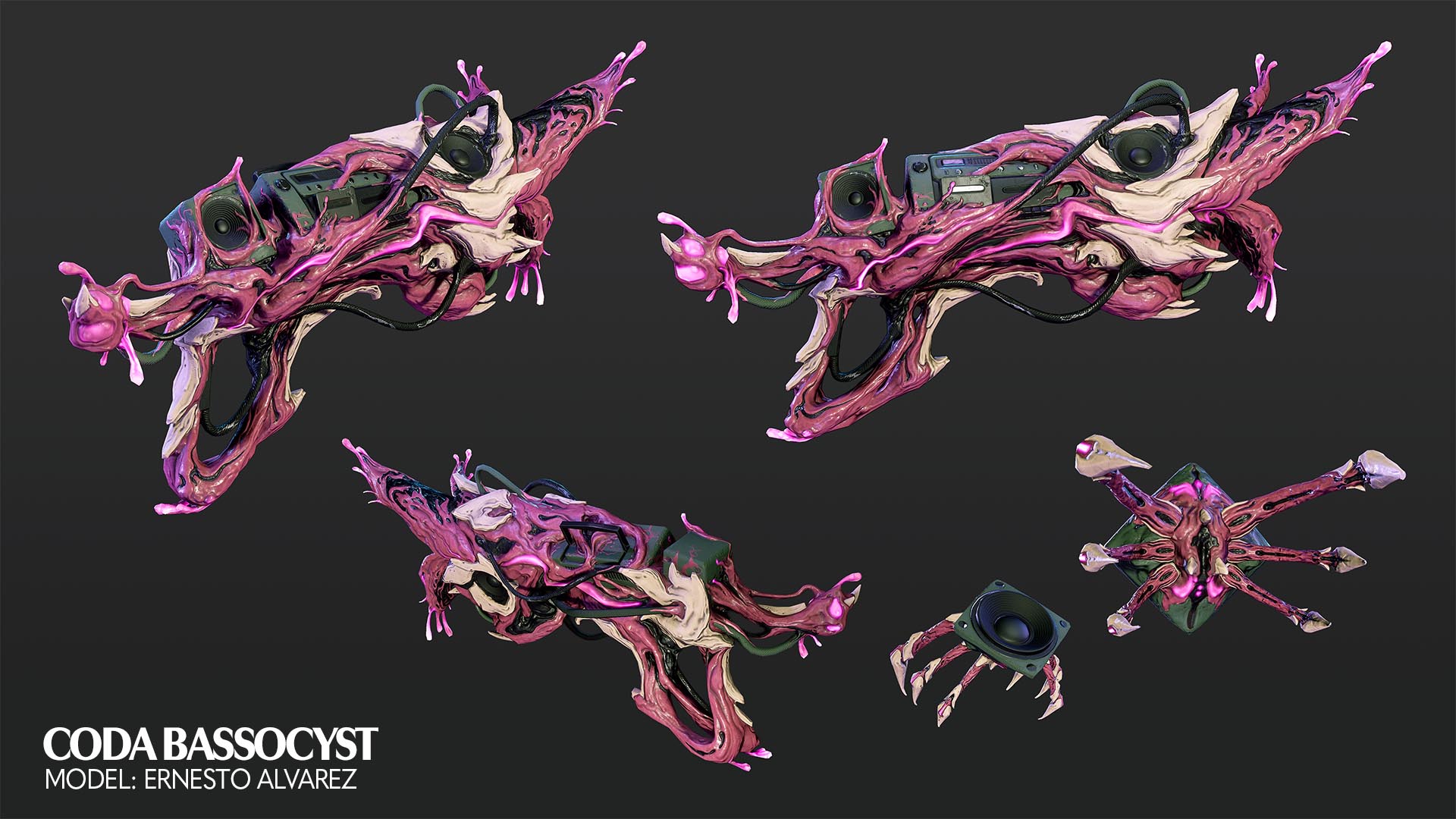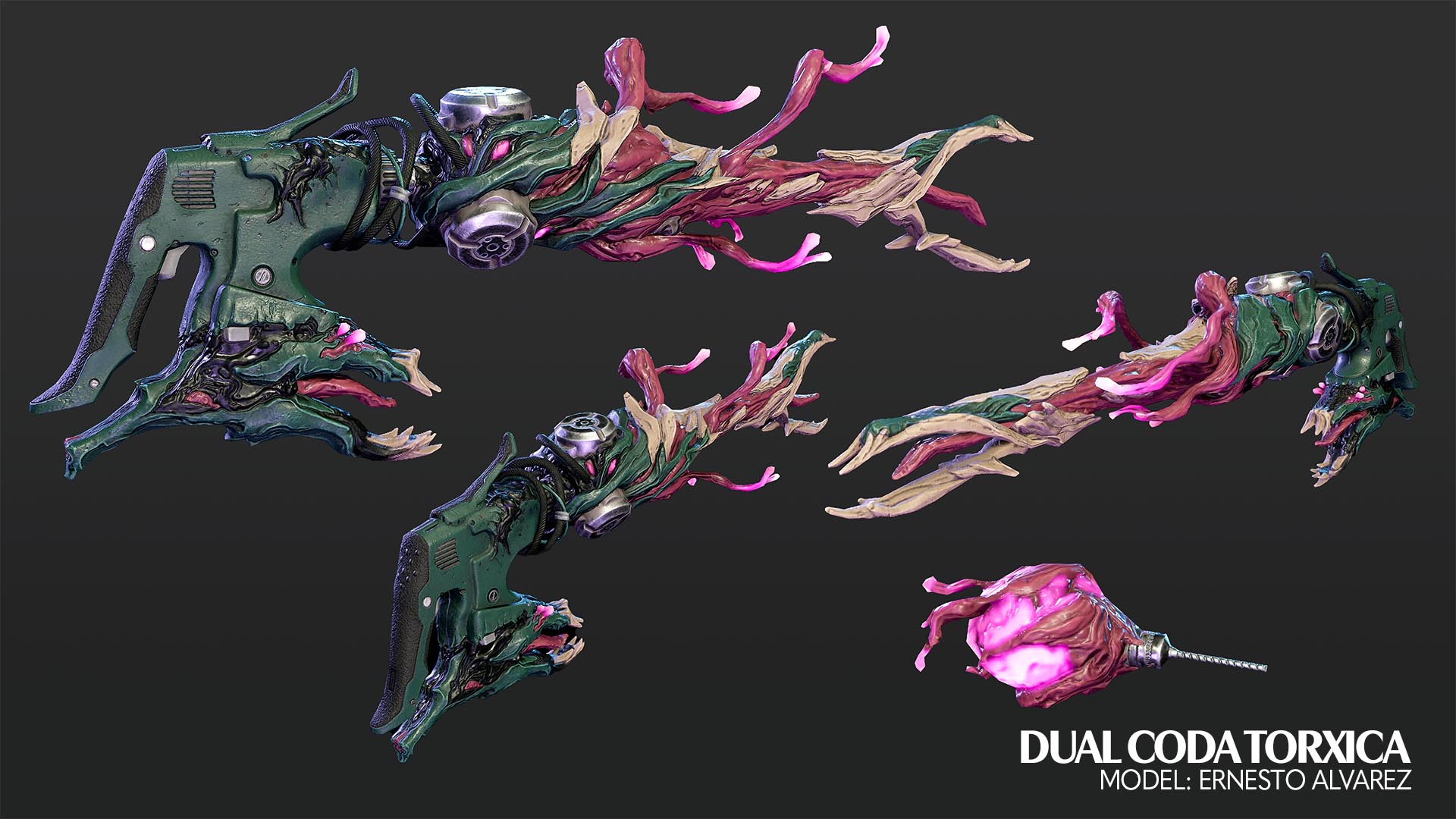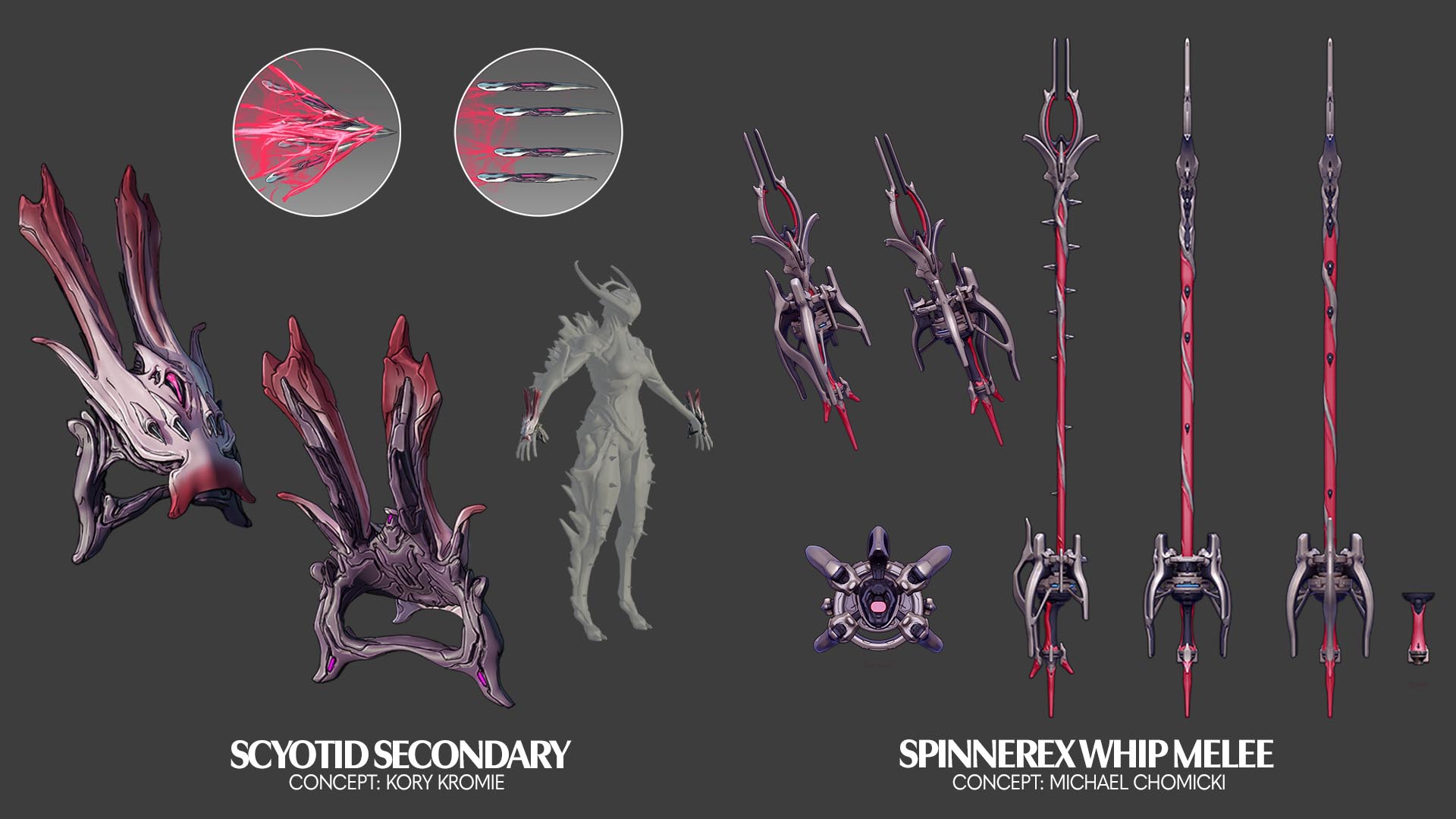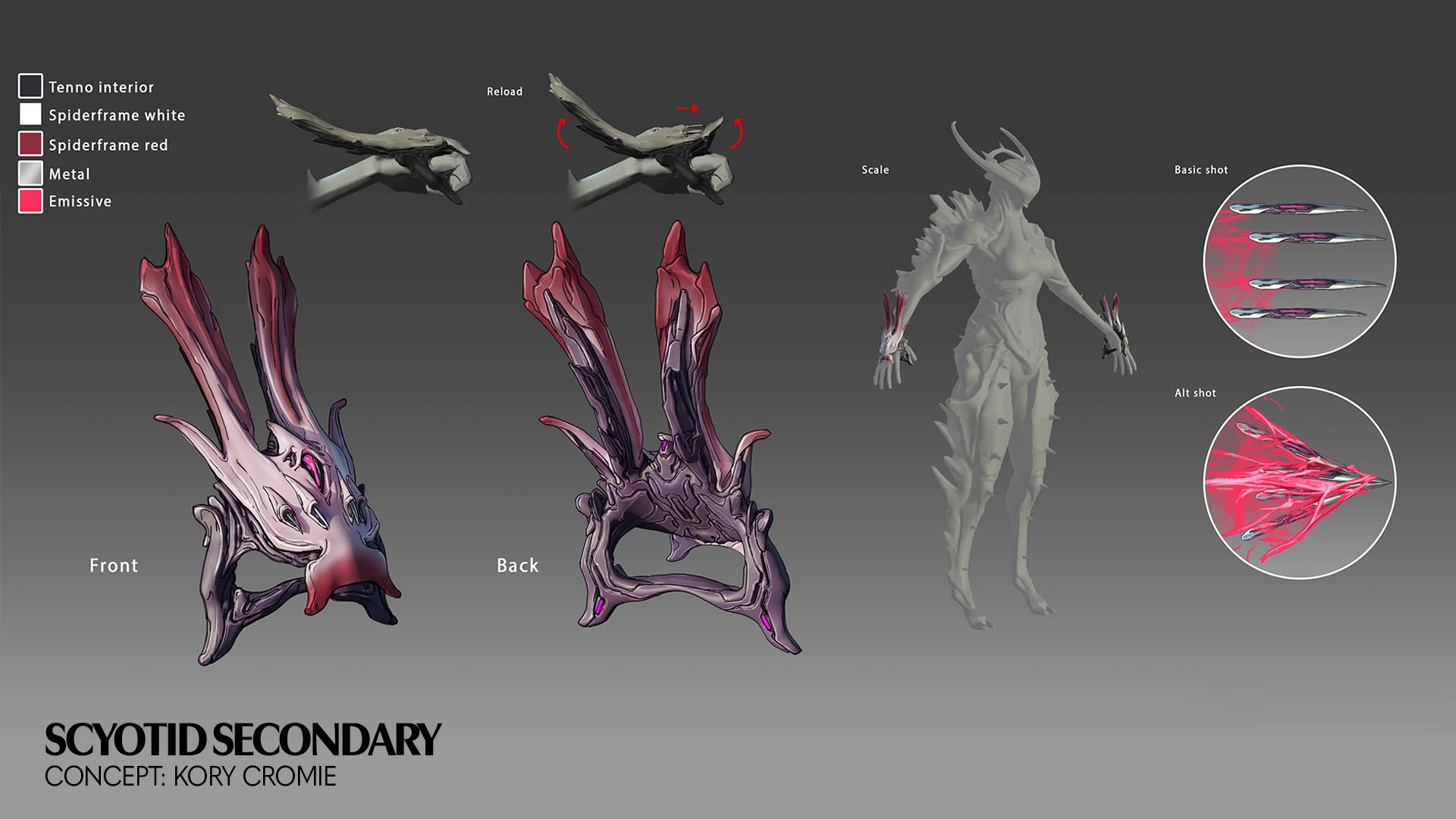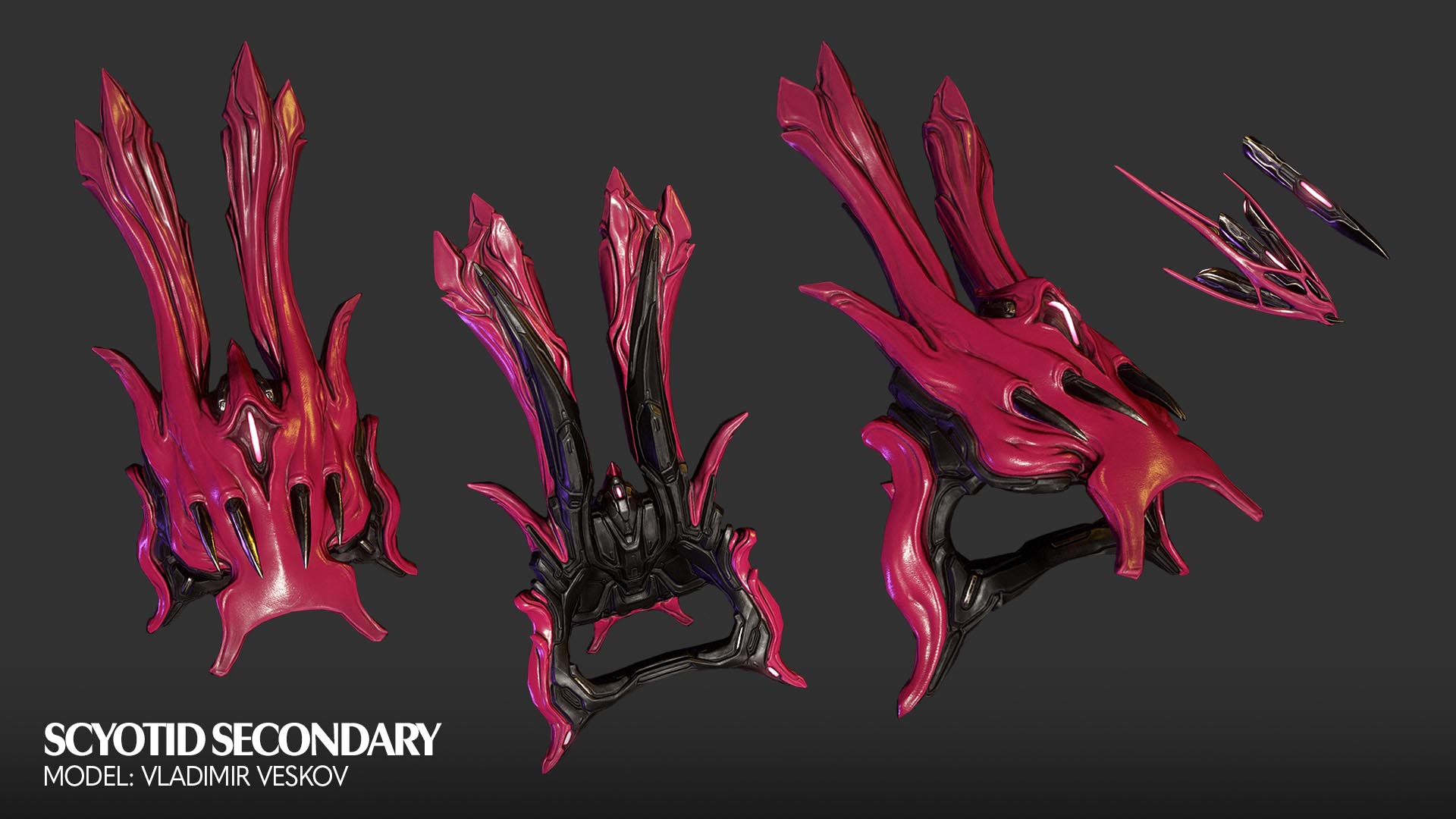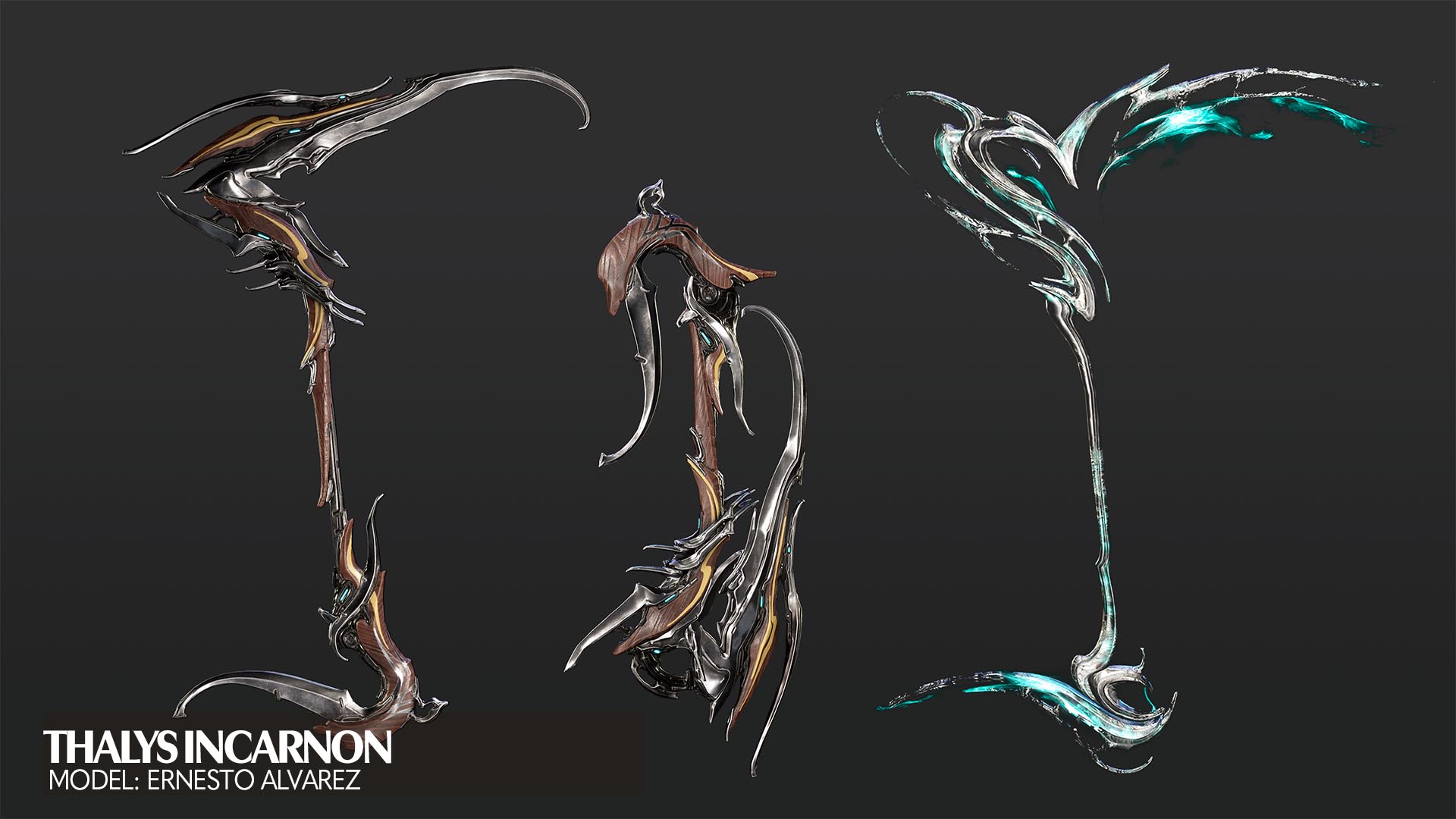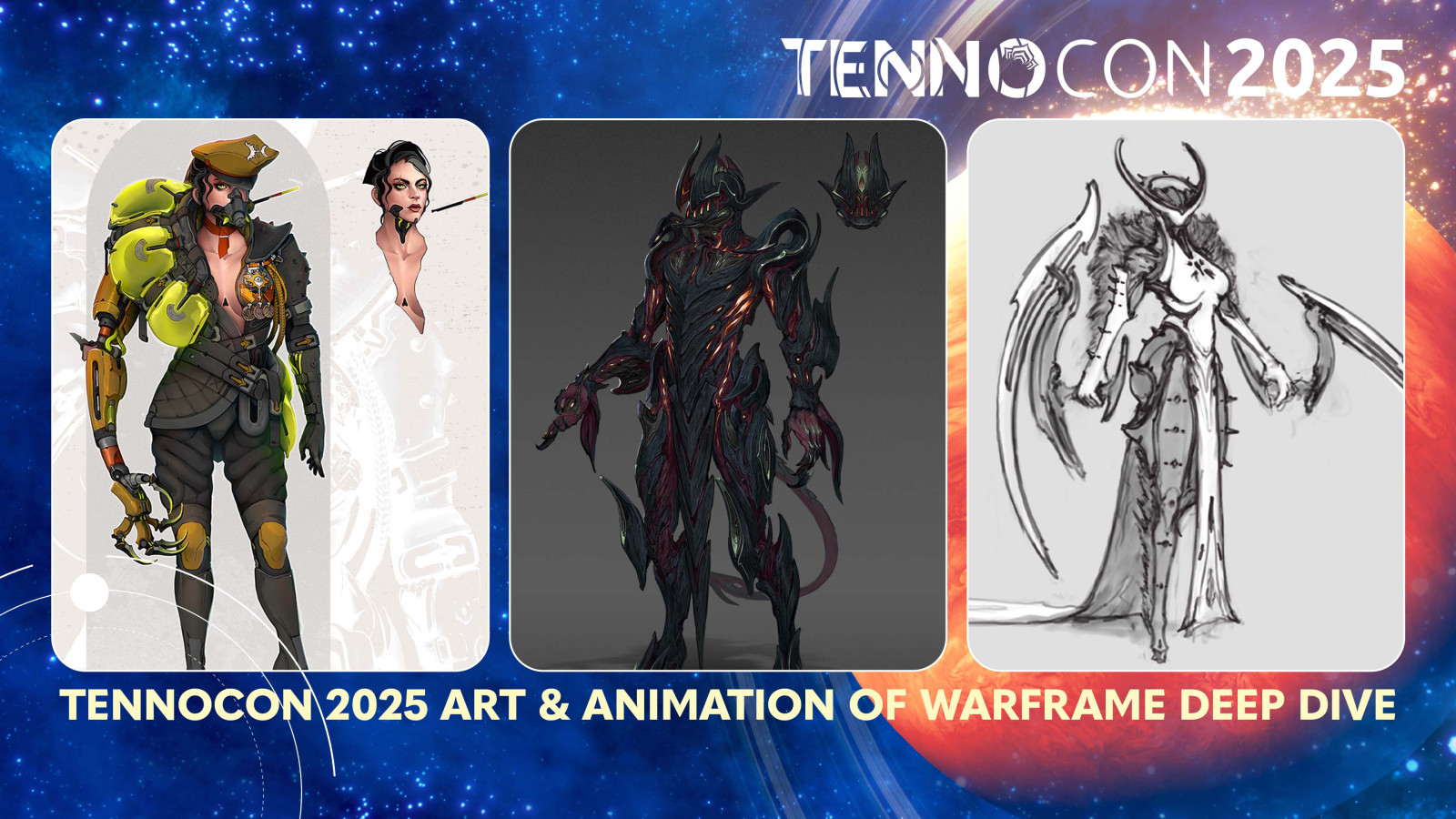
It’s been a wild journey through the haunts and mutated environments of Höllvania. These places and the creatures that inhabit them come alive thanks to the work of our art and animation teams. In this companion piece to our The Art & Animation of Warframe panel at TennoCon 2025, here’s some insight into the artistic effort required to bring our most recent Warframe updates to life.
The Hex Quest Cinematics Mocap & Animation
ARTIST: Elyse Gymer (Warframe Principle Animator)
What was the process of getting ready to mocap and act a scene from The Hex Quest? Was there any kind of special preparation needed to get into the characters' headspace?
For me, motion capture is very similar to capturing video reference for an animation I'm working on, so the process is very familiar. Once the characters get to us, they usually have concept art, a narrative brief, some amazing voice acting and sometimes even a character model already — so the characters are usually fairly established in terms of personality. Figuring out how the character is going to sit, stand, move and emote is all part of the fun. I think as kids we all like playing pretend, motion capture is just the adult version of that.
Once you have a clear idea in your head of the character, it's about learning your lines and cues, much like in a stage performance. The acting you do leans towards pantomime versus film acting, because you "lose" a lot of data in the motion capture and compression. So slightly over-exaggerating breathing, gestures and motions so it reads well in game is important. Also it's easier to "pull back" acting performances than it is to "add" them in. Geoff usually has a clear idea in his head of what he wants from the performance, so he'll give us some direction to start with and we do takes, getting additional direction until we have it in the bag.
What was your favorite scene to mocap/animate in The Hex Quest?
Rusalka's interrogation monologue was probably my favourite one to motion capture. There was lots of back and forth on the logistics of making the body swap work. The scene was so serious and the dialogue and voice acting was superb. It was a great puzzle to figure out.
In terms of animating, my favourite to animate was Lettie's death scene. I got to do Eleanor going crazy and an awesome mid-air jump with a tongue lashing out. Getting Lettie's line of "Making sure that you are still you," just right, with the emotion, was my favourite outcome. The kissing scenes were also really fun to figure out. I got to direct how those went and wanted to err on the side of romance and leave things to the imagination where possible... I even made Rebb's monster tongue Eleanor request work out, haha! Any time I get to do something heartfelt or creepy is a good day! Warframe has such amazing characters and stories, every day is something new and exciting.
Any interesting or silly mocap moments during The Hex Quest that you'd like to share with the players?
Apart from me breaking character and laughing a whole bunch? Nothing hugely stands out. Aoi's death cinematic was physically a challenge trying to get her voice acting, with the breathwork and strain in sync. Luckily, there's a reason I'm an animator and not an actor by trade — I much prefer being able to push and tweak the performances after we shoot the motion capture. We get the foundation laid in mocap, but a lot of the real magic is hand-crafted after the fact. We don't capture any facial or hand performance and ideas will often come up as we're working on it.
The Backroom Concepts Video
ARTIST: Dean Field (Warframe Lead Environment Artist)
As a lead environment artist on Warframe, I get the opportunity to oversee many of the projects that come together to establish the setting for our releases. For Warframe: 1999, I was thrilled to be a part of the team that brought 'The Entrati Backroom' from an idea to the incredible space you see today.
Pretty early on into production on 1999, we knew the Backroom would be crucial for the update. We needed an intuitive way to bring the functionality from the player’s ship back in time and into this exciting new era of Warframe. It would be the setting for key narrative moments in the quest and romance system.
In terms of the presentation, the backroom needed to look and feel like it was Entrati’s secret lab, but also a warm and inviting space that players would be excited about adopting as their new home. To help solve this, we decided on a warehouse with a loft-style apartment. This approach allowed us to divide the level up into distinct areas to support our team's goals.
Because this was Entrati’s secret lab, it also meant that each device — such as the arsenal — and all the functionality from the player ship, would need to be reimagined to fit this new aesthetic and incorporated into the space. This turned out to be quite challenging for the team, but it has become one of my favorite aspects about the Backroom.
One thing you may not know is that an early iteration of the Backroom was actually a more-traditional tailor shop intended to be a store front on the city streets rather than inside the mall. This ended up feeling too disconnected from the wonderful social space we had created, so we added a clothing store on the upper level. We then added Entrati’s portal device inside one of the fitting room stalls to help explain why such a large warehouse was connected to the back of a clothing store and still make use of the work that the team had done up until that point.
From the many talented artists, designers and programmers who were involved in creating the backroom, we hope you have enjoyed decorating and making the space your own as much as we have enjoyed seeing all of your wonderful creations!
Major Neci Rusalka Concepts
ARTIST: Liger Inuzuka (Warframe Concept Artist)
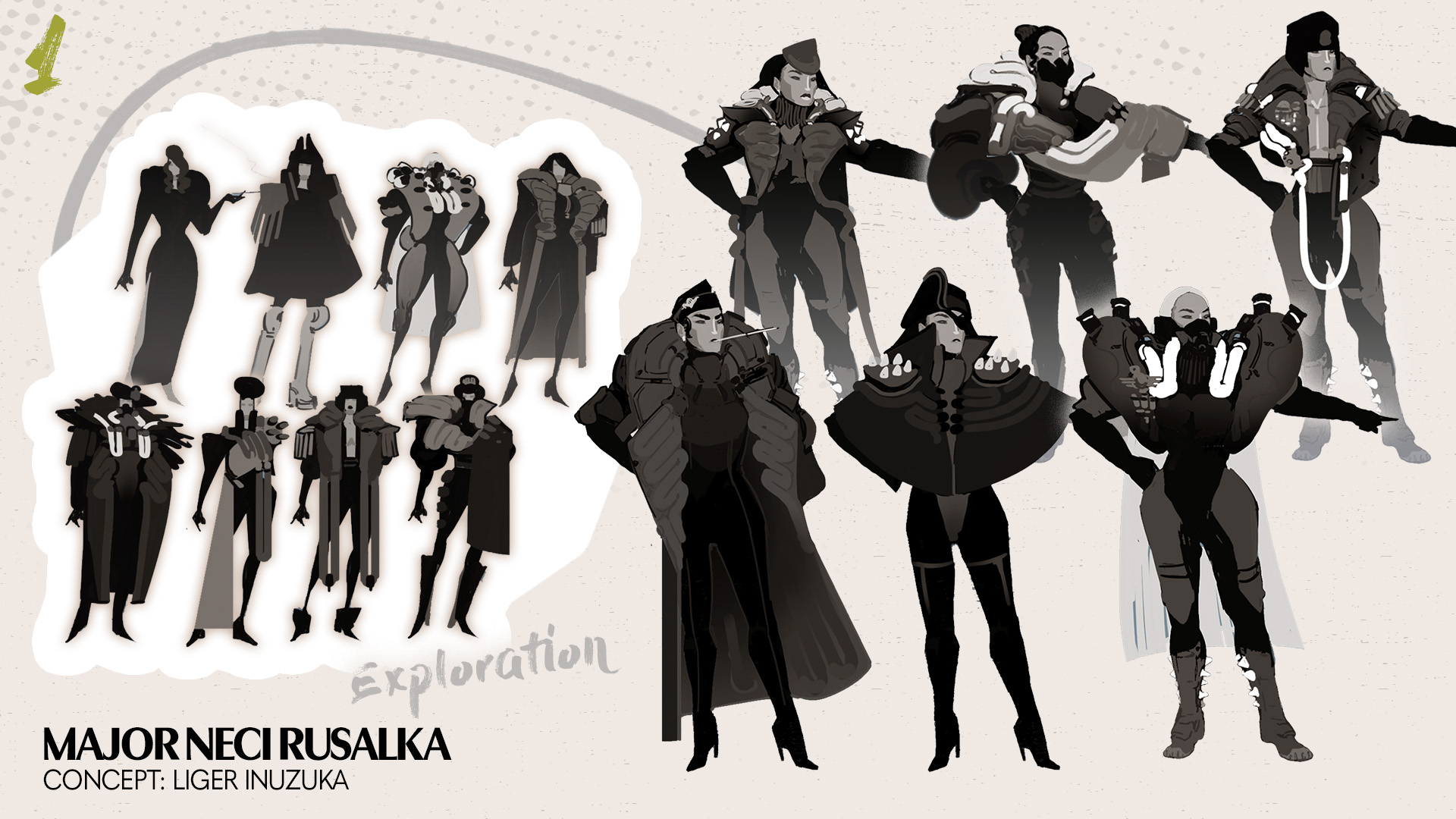
The entire 1999 expansion was the first time I was given the chance to create full characters: voiced and animated from scratch, not skins or cosmetics, which is our main repertoire. From Loid, to the Hex, to the Scaldra bosses Rusalka and Viktor; I did not expect the honor of designing nearly all the main faces of the expansion!
The Major was the first boss we designed. The goal was to create a serious, powerful-looking female leader of the Scaldra army. Starting always with sketches and working our way up, I included visual cues that could denote a character of higher status; bigger collared lapels, long officer coats, a cigar for the coolness, medals and military hats and an exposed face. When the army mobs are faceless, a character with a human face draws your attention and empathy in comparison.
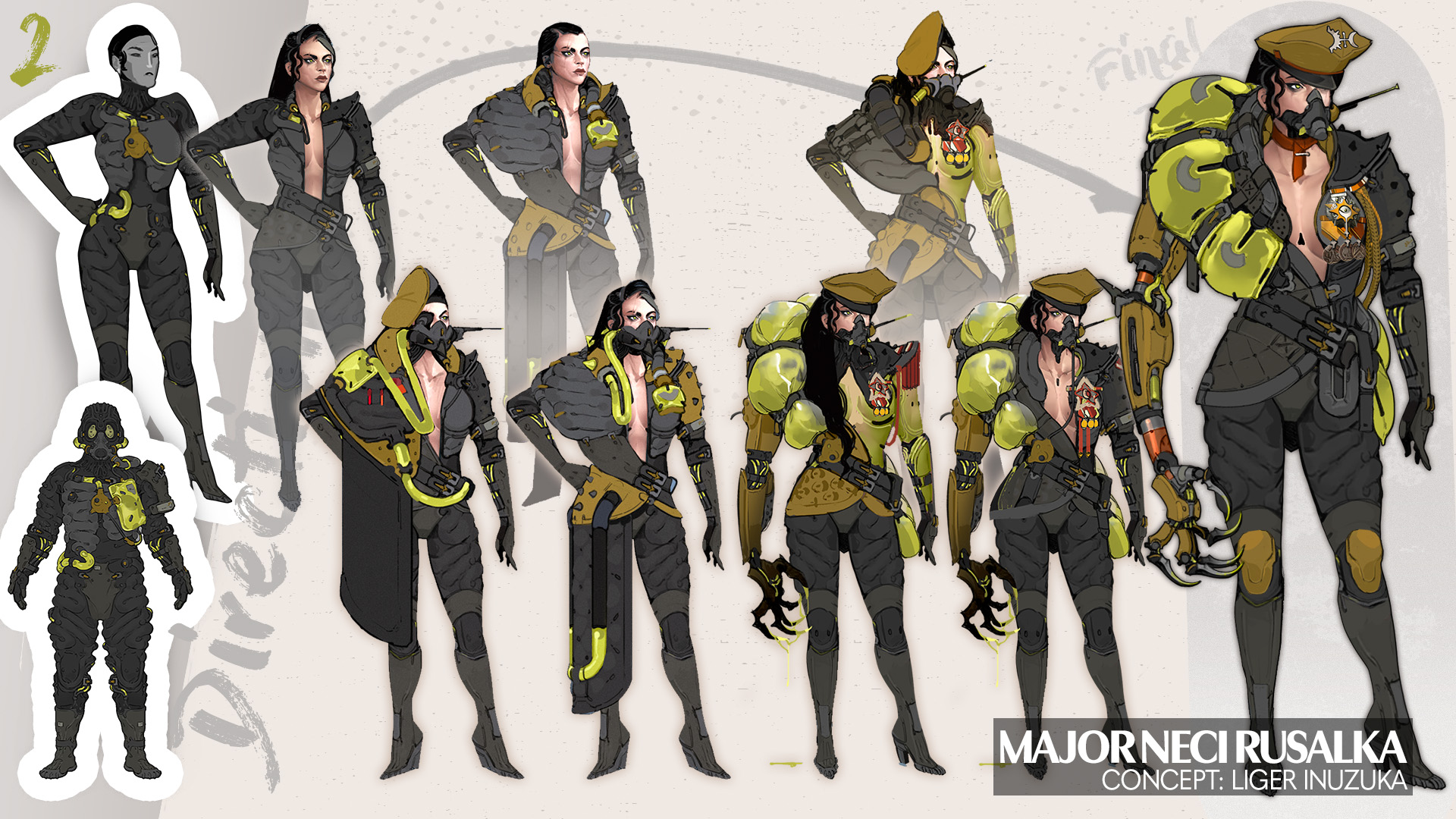
Near-completion one feature that was greatly discussed was her open chest: a point of creative contention. Should a female character show so much chest, particularly in a plagued environment? However, our Art Director Kary Black made a comment in defense of our choice in the open chest — that being that it shows a sense of “bravado” in the character. At this point The Major was nearly completed, but I wanted to test one last push towards this idea of "bravado."
As the last step, I took all I designed and exaggerated it further: longer hair, bigger hat, leaning forward in an aggressive fashion, larger Scaldra Efervon bags mimicking the shape of a coat collar and one big robotic, clawed and dangerous-looking arm. The arm is not very 1999-era appropriate, however the more maximalist appearance was instantly loved! Later, seeing The Major animated live in her introductory cutscene was phenomenal. I was delighted to see how she landed on the ground with a 'clank' revealing the metal claws — quite intimidating and lovely by the animation team to focus on her unique features.
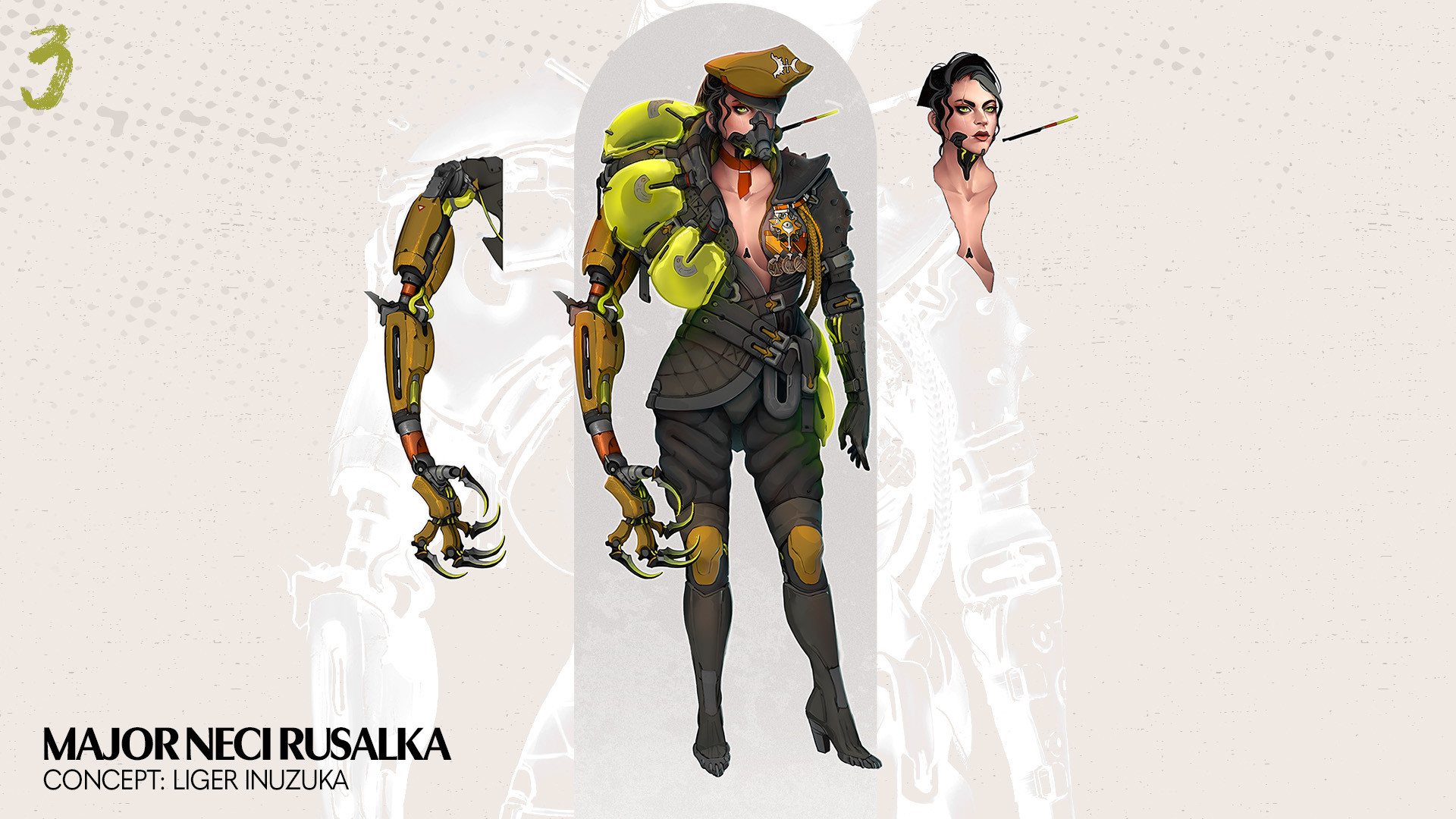
This feeling was then also translated to Viktor, who is shorter than his lead, visually denoting the relationship and hierarchy of the characters. I decided to give Viktor some snake motifs to suggest his snake-like behavior. In some ways, Viktor is the Starscream to Rusalka's Megatron.
You can see more of Liger’s Major Neci Rusalka work here
Velimir Concepts
ARTIST: Liger Inuzuka (Warframe Concept Artist)
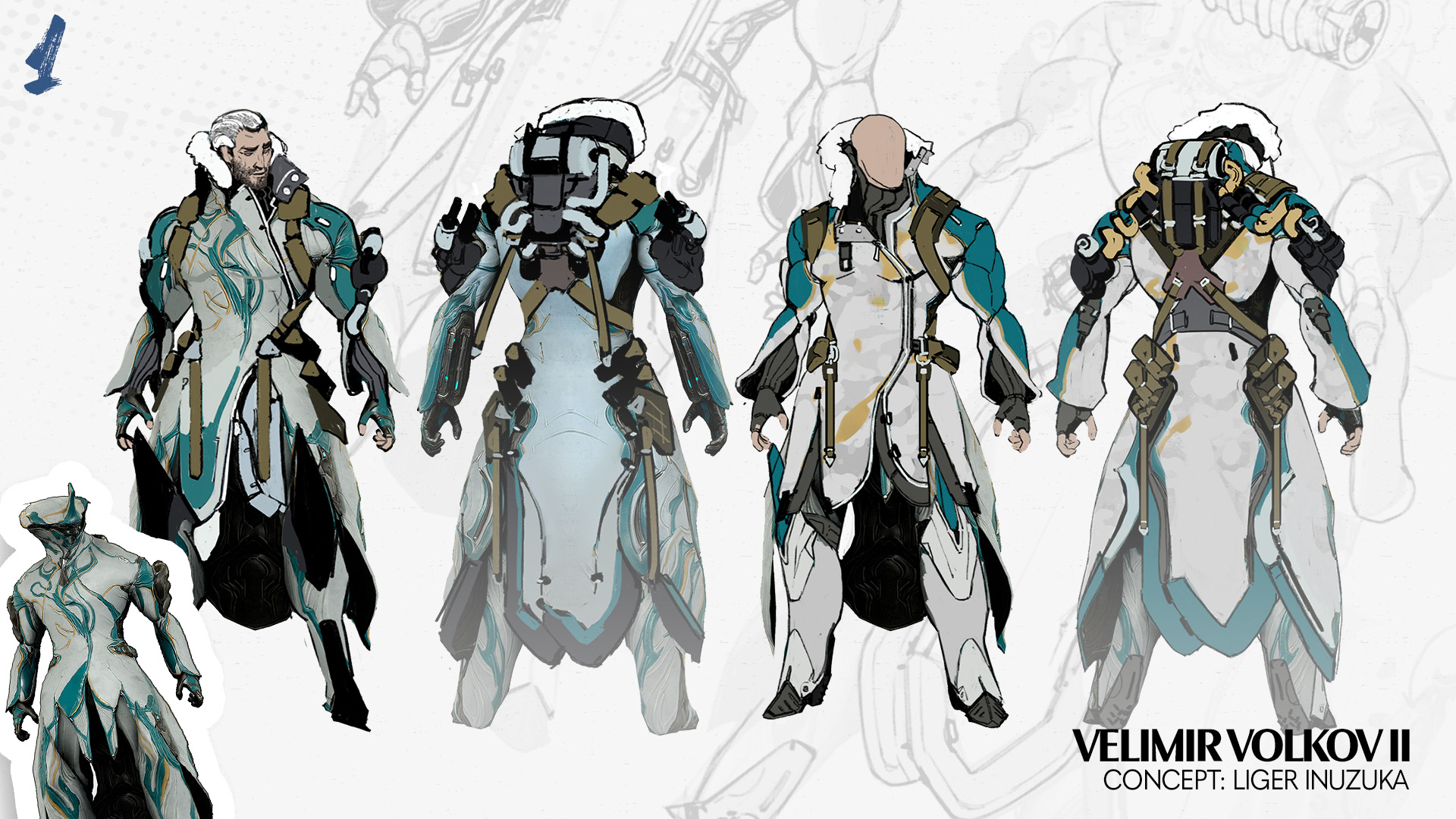
Frost is a special Warframe to me, as he is the reason I started playing Warframe back when the Beta first opened. I thought it was a beautiful design at the time and wanted to "place this race"-thinking Warframe was a traditional MMO structure. Imagine my surprise back then being offering the first beginning three Warframes, and learning that I have to grind and build a Frost!
Jest aside, for the first expansion of Protoframes beyond the Hex, I pleaded with Rebecca to include Frost. There were lots of challenges with the first six; questions about whether they were Deluxe Skins or just added attachments; how much of the original Warframe to keep versus making them more retro for the era; how to tint the characters for player customization, etc. Taking all the challenges we learned from making the main six Protoframes, I translated that into Frost — in some sense, he is the culmination of my best efforts and learned lessons.
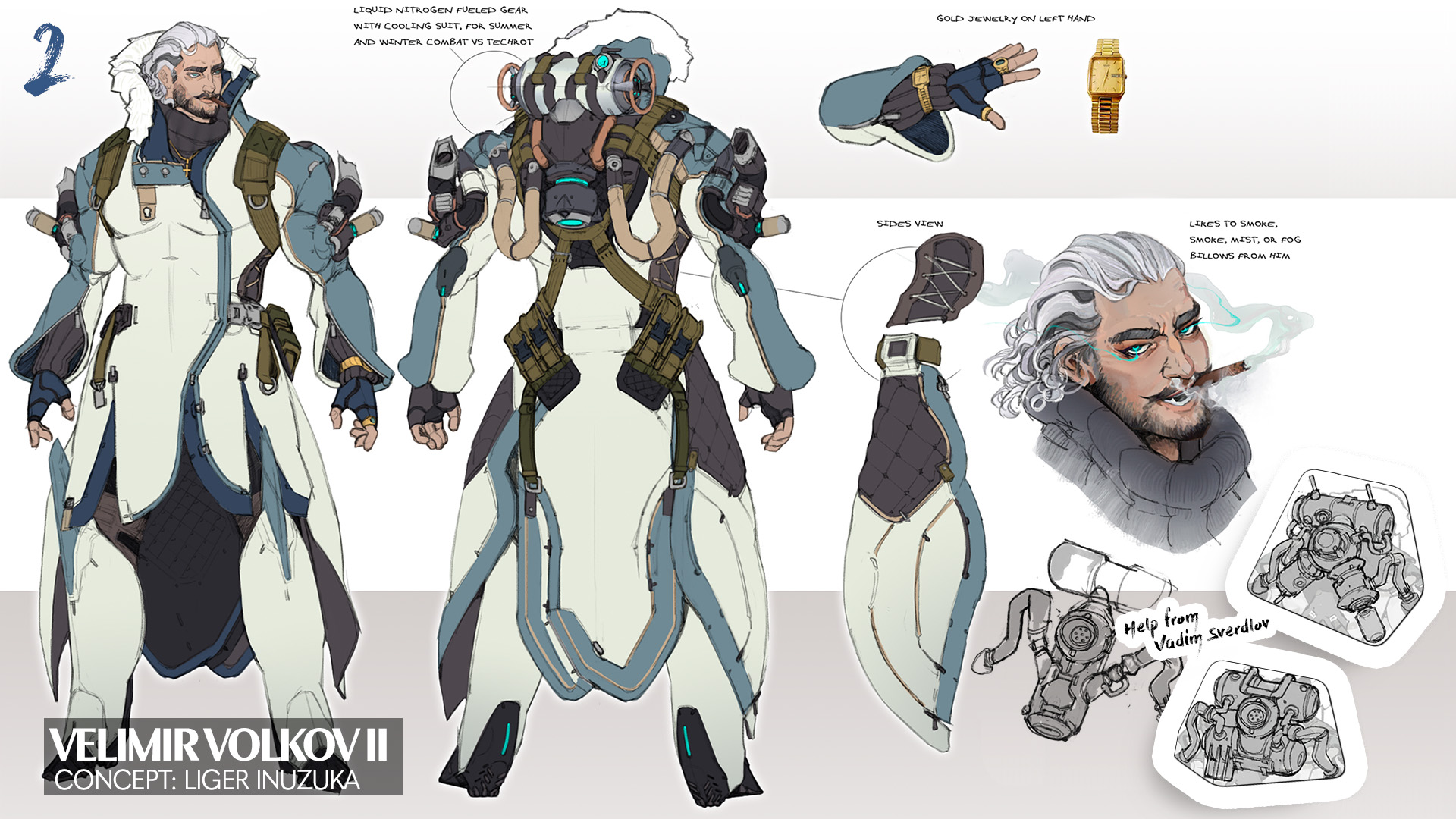
When designing a Protoframe, I first would identify what is the most interesting or distinguishable feature of a Warframe. Then focus on those features, enhancing them, interpreting them in the style of the retro, army-fantasy aesthetic that is Warframe: 1999. In a way, reversing the Warframe style back into something traditional. There is a rule of thumb when designing for Warframe — we should not create something literal, everything is redesigned or mutated to be a little weird, a little sci-fi, just "Warframe."
In this case, I did the opposite. Frost's most distinguishable features, I would say, are his helmet, his coat, his exhausts and the tube system on his back. So, his wide-brimmed helmet was remade into an upright coat collar, thick and suggesting a winter coat — which he is indeed wearing, adding layers, zippers, binders, fasteners down the robes to suggest a thick, layered coat. Last but not least, his backpack and exhausts I reimagined into an entire sci-fi liquid nitrogen system, suggesting he has coolant tubes running through his coat regulating temperature, finalizing this wintertime soldier impression.
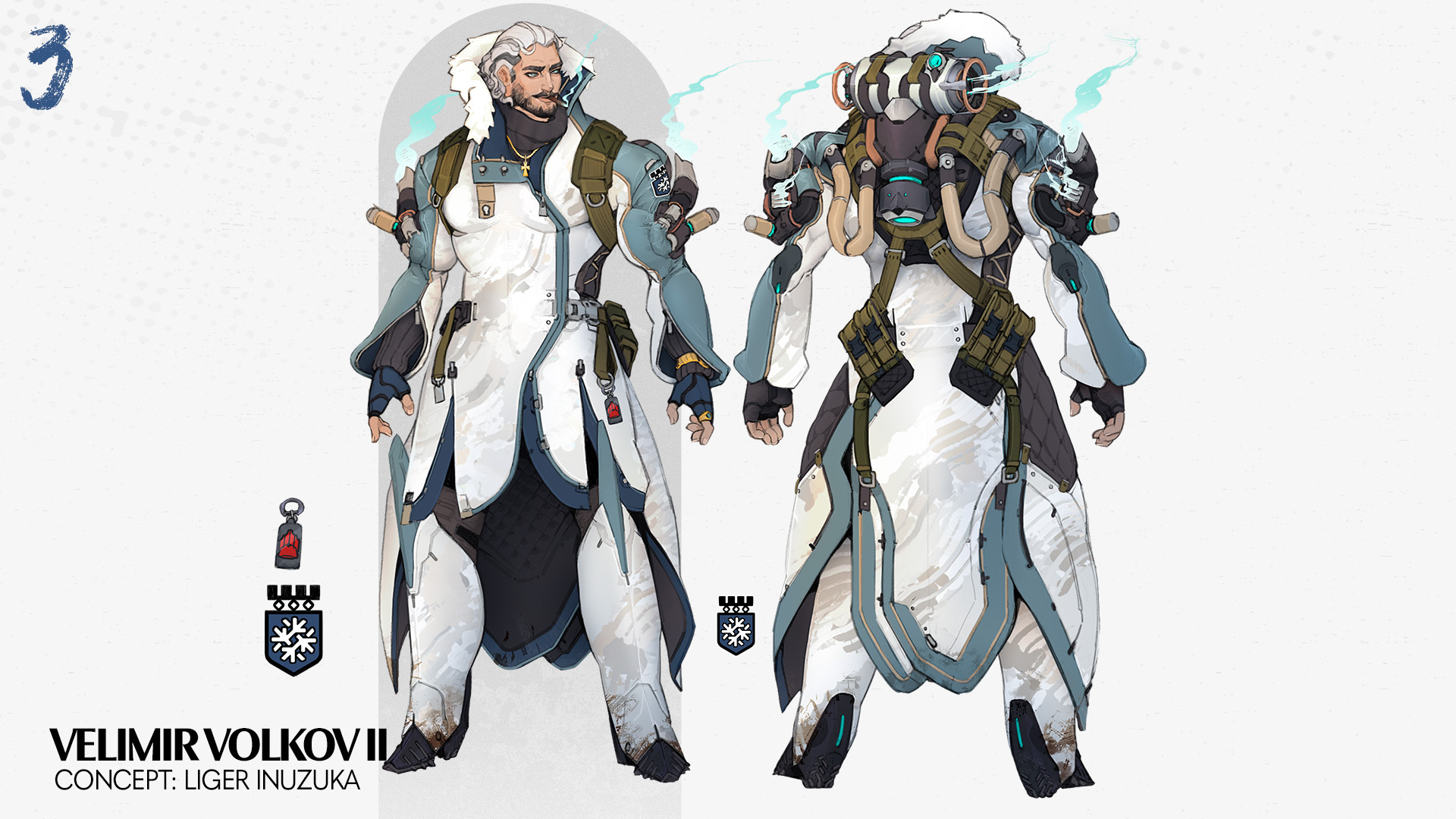
I wished to include my own culture into his character, being a Slavic person. But more importantly, he’s a person I wish to become, sort of like a goal. As you can imagine, Frost has some "wise guy" undertones. His name derived from my in-game handle. For some reason when making my account, I defaulted to the name "Volkovyi" and have kept it ever since, so when choosing a name for Frost we brainstormed some Slavic names using the letter V. Rebecca liked the name of Velimir, meaning "Great Peace." I only wished Velimir could have kept his cigar and fur somehow in game, for ultimate coolness factor!
You can see more of Liger’s Velimir work here.
H-09 Efervon Tank Concepts
ARTIST: Kory Cromie (Warframe Concept Artist)

For Warframe: 1999, the update called for the player to fight a mutating tank boss. The tank itself was based on a combination of the classic real world T-55 and experimental T-28 tanks. When it mutates, it becomes more of an octopus/spider creature with the turret lifting up and appearing a little bit like a scorpion stinger.
When designing the boss, it needed to have accommodations in its details that would allow it to work with the planned game design, like having valves on the sides could indicate weak points that could be blown up. The biggest consideration was of course how the tank would be able to transform into a Techrot monster. This mainly came down to designing enough openings into the base tank to allow for the multiple arms and center trunk to come out when the new phase started.
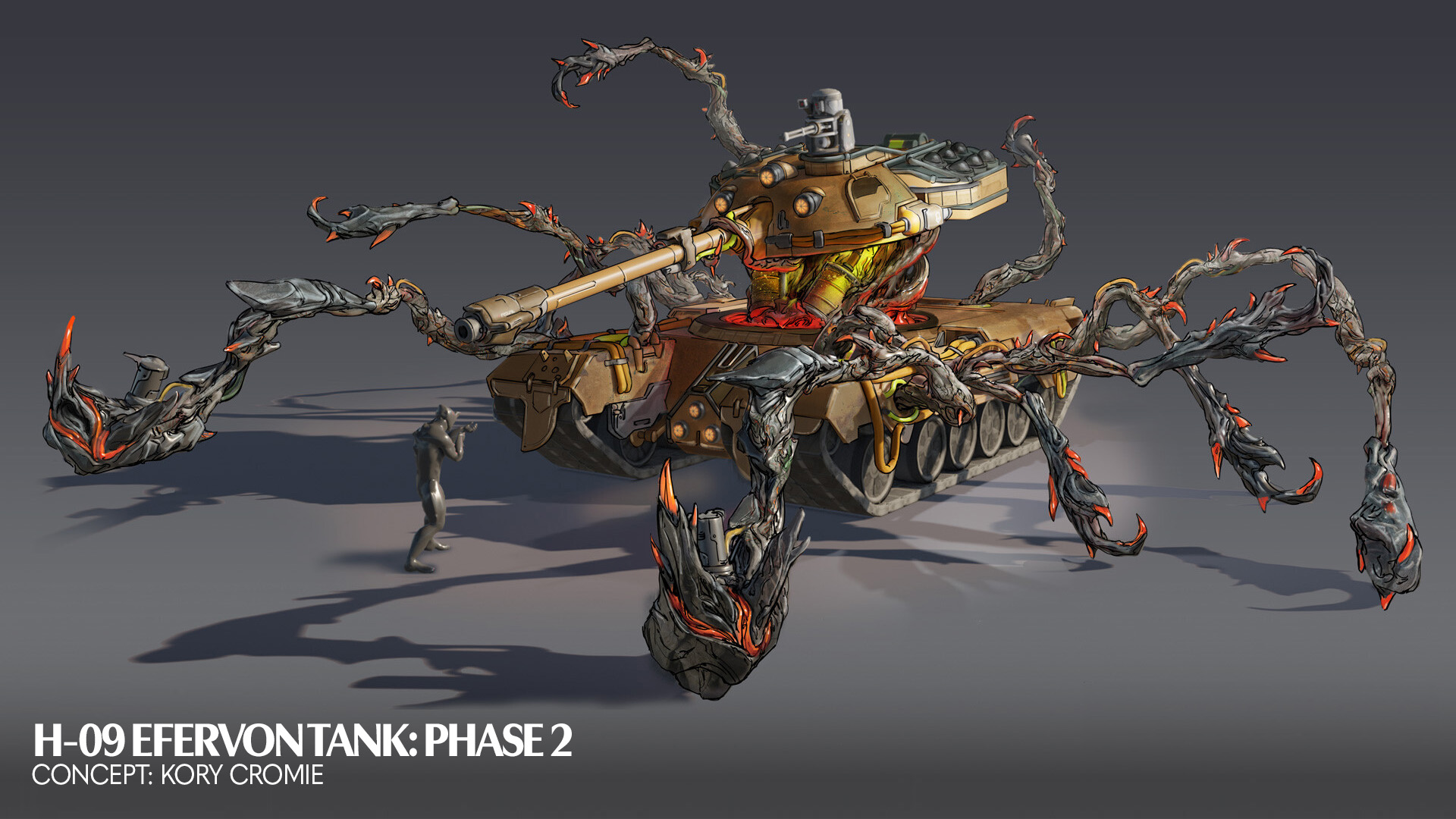
It was a fun challenge coming up with a uniquely Warframe-flavoured tank. I made it slightly different from its real world counterparts in every way I could, from how the armour panels are shaped, to even just changing the number of headlights it had, which ended up giving it a slightly insect-like compound eye look. I hope it was fun for the players to fight against!
Kaya Concepts
ARTIST: Nathan Desjardins (Warframe Senior Character Artist)
One of the first things I started exploring in Kaya's design was how to visually portray antimatter in an interesting way while staying on theme with 1999. The difficulty was that in theory nothing about antimatter is more visually interesting than regular matter, the party occurs when the two meet: so I chose to try and put visuals to some kind of stable reaction between the two. Creative liberties were definitely taken.
I landed on a device/regulator she could wear that featured the reaction in glass vials. Its construction was made to look simple and machined. I felt it could be fun to insinuate she was the one that threw this thing together in an effort to help control her newfound powers. Thus her character took a turn towards more of an engineer or child prodigy.
The next big design element was the Warframe strain/infestation. With the Hex serving as an early exploration of this, I wanted to push the visual metamorphosis between human and Warframe a bit more with Kaya. Playing with the idea that the virus eats away at the flesh, I landed on showcasing the aftermath across her arms in various asymmetrical pockets to emphasize the organic sprawl of the infection. After nagging the programmers — thank you guys — they updated our skin shader, making it possible to seamlessly blend the two. We can now even accurately express metals and emissives in skin, so look forward to potentially more techno-organic materials in the future. Last, but not least, we had to sprinkle in more of the 90s, so in come the chunky sneakers and stickers. Throw in the high-bun hairstyle as a homage to Nova's original silhouette and you have your key ingredients, the rest was just a question of dialing in the balance and finding some fun colorways.
Backroom Modding, Arcane and Arsenal Concepts
ARTIST: Alfio Capotorto (Warframe Concept Artist)
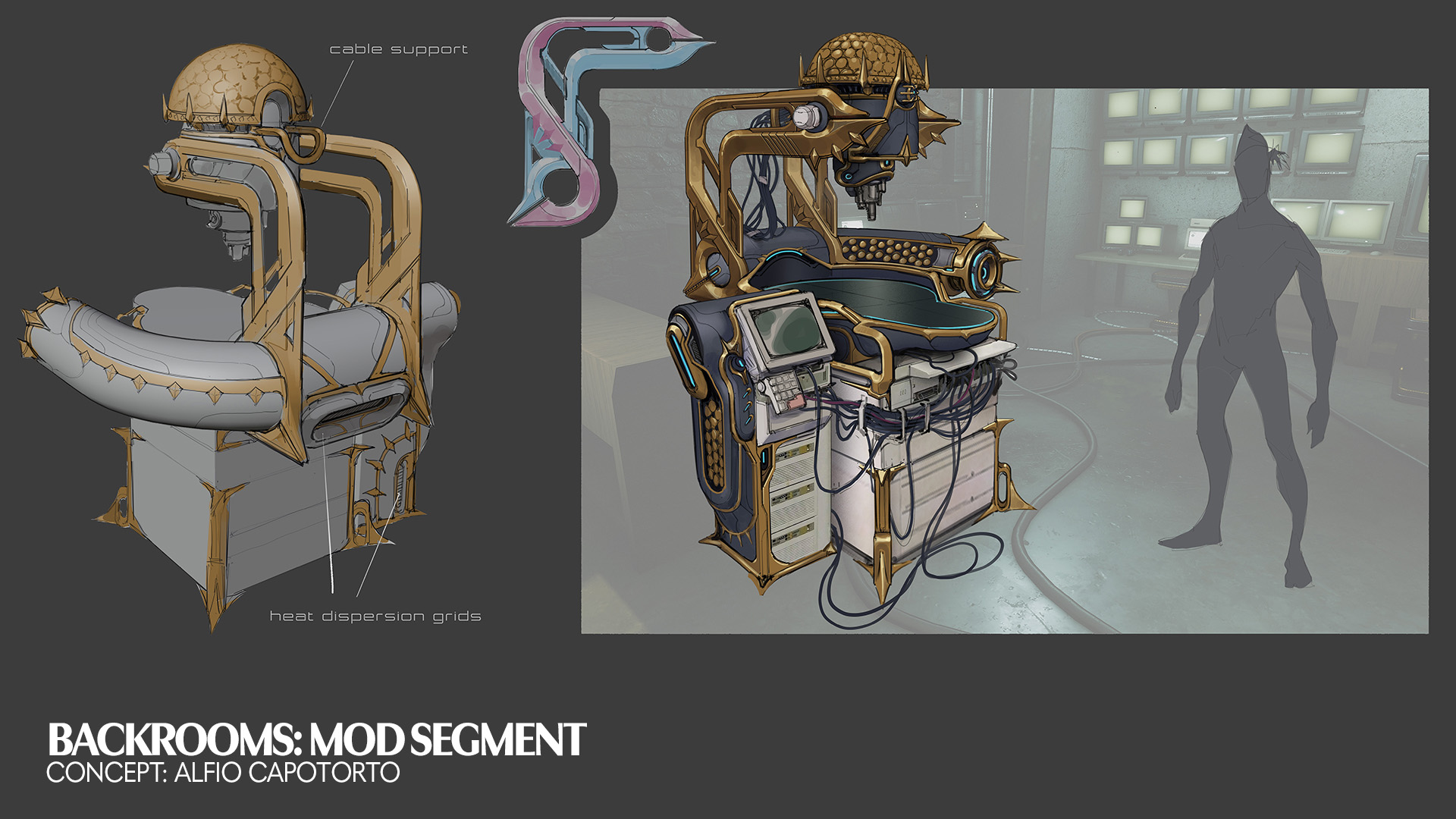
I started at Digital Extremes right when Warframe: 1999 was close to release. With little more than a month of time there was still quite a bit of concept work to be done and I had the pleasure and honor to work on some parts of the Entrati Backroom.
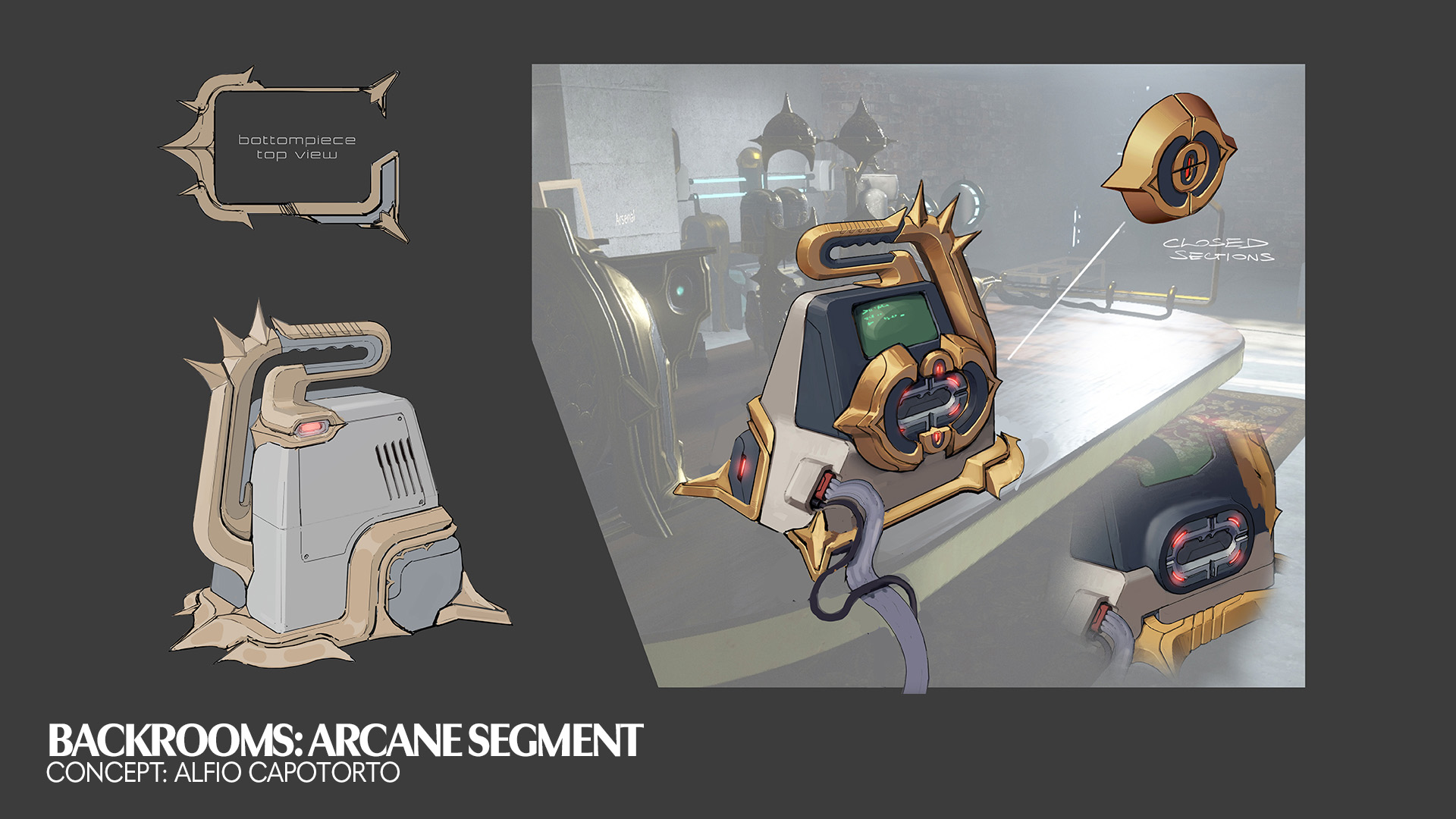
My first task was the Modding Machine! Getting the Entrati style to look right wasn't easy and having the 90's tech thrown in the mix added another layer of complexity, so I spent lots of time looking at all of the existing assets to soak in the style.
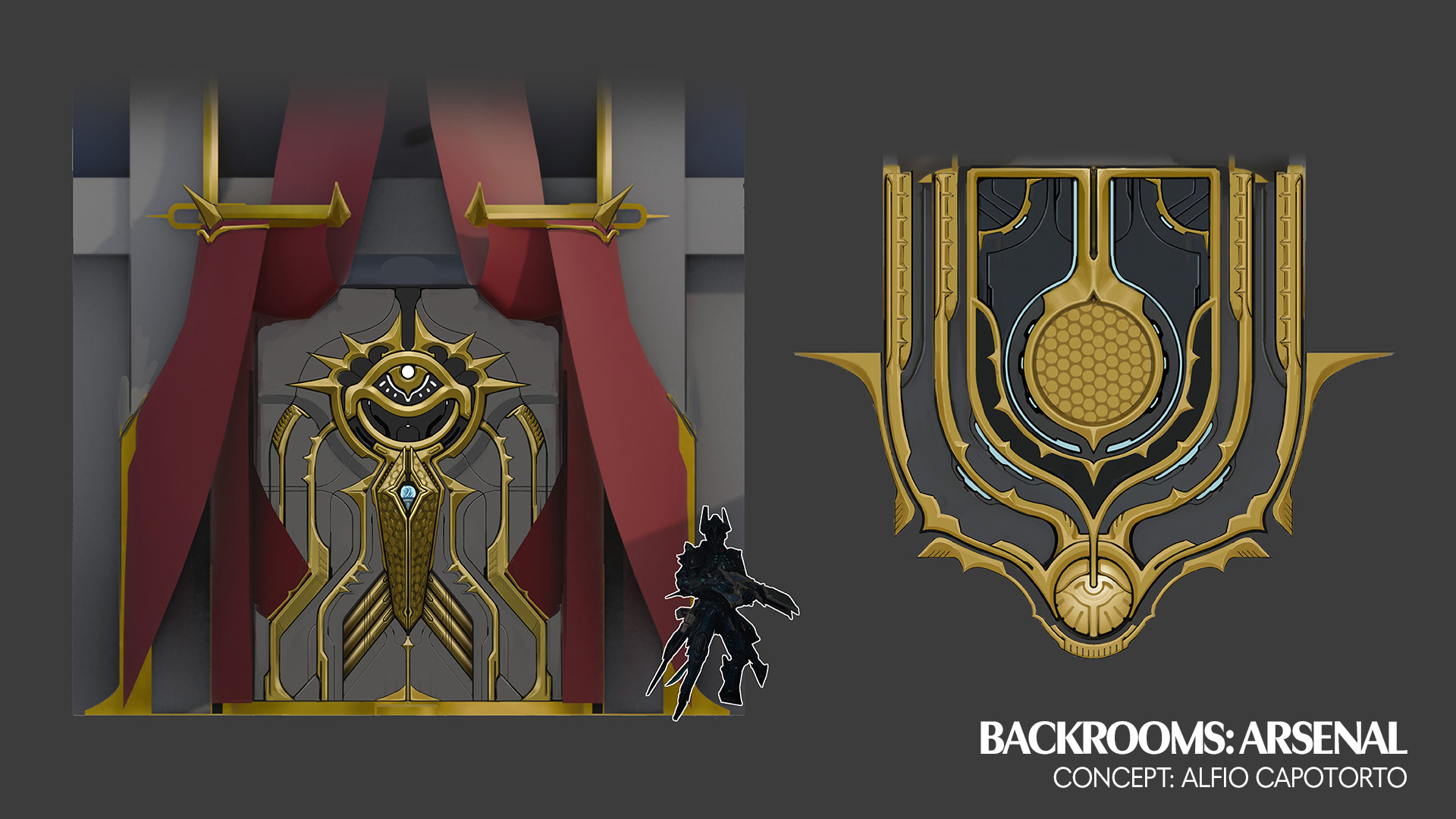
The Arcane Machine was another fun one before getting hit with the big one, the Arsenal! With barely any time left, I'd been trusted to come up with a cool design for it that would "open up" as the player approached. So I designed a mechanism that would also make for a proper backdrop for everything that the Arsenal is for (fashion in primis OF COURSE). My favorite detail is the three pistons releasing in quick succession, giving it a somewhat high-security vault feel that I thought was appropriate.
The Unseeing Herald Model
ARTIST: Olena Shchypanovska (Warframe Character Artist)
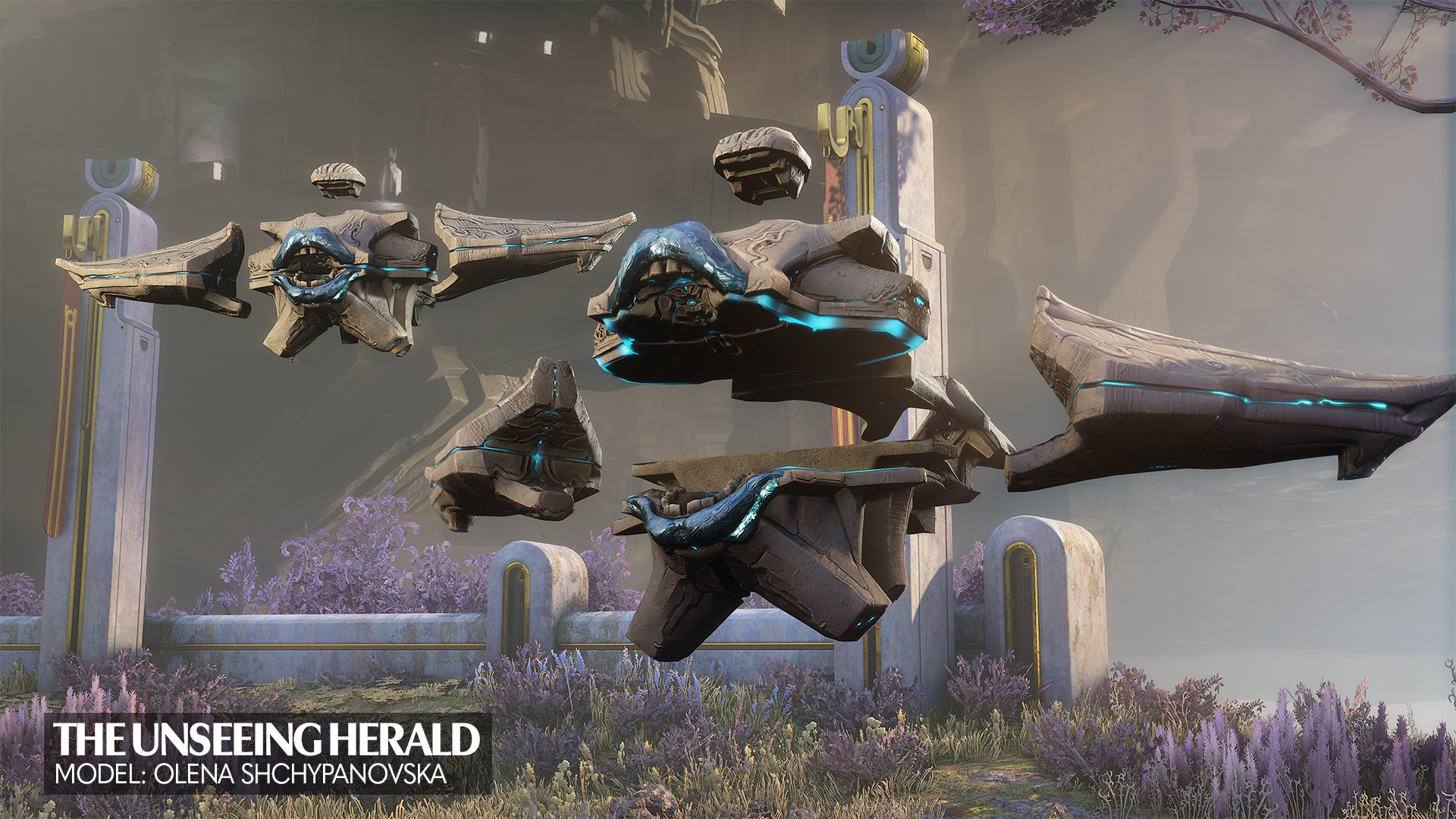
When I first saw the concept for Murmur, my initial reaction was something like: "Okay, this thing is hilarious… but also kind of awesome?" I really wanted to preserve that eccentric, weird charm in 3D without turning him into a full-on joke. It was a fine line to walk: keeping the design fun and expressive, but still making him feel threatening enough.
Naturally, the lips were the star of the show; they took up most of the model! I started by blocking out the general shapes to find the right balance between goofy and unsettling. The mouth, of course, was the trickiest part. It’s open, full of teeth and constantly in motion, so I had to go full orthodontist mode for a while, digging through dental references to make sure everything looks ok.
Technically, the model didn’t cause too much trouble; no big topology issues or limitations to wrestle with. But the teeth definitely had their own ideas. During one of the early animation tests, they just… took off. Completely disconnected and started flying around like tiny missiles. Someone in the team chat wrote "We need a dentist, ASAP," and I couldn’t stop laughing. Honestly, I think if players saw that version, they’d love it too.
Working on Murmur was one of those weird, joyful tasks that reminds you why making games is fun. It’s a little strange, a little silly, and totally satisfying in the end.
Zephyr Conquera Skin
ARTIST: Olena Shchypanovska (Warframe Character Artist)
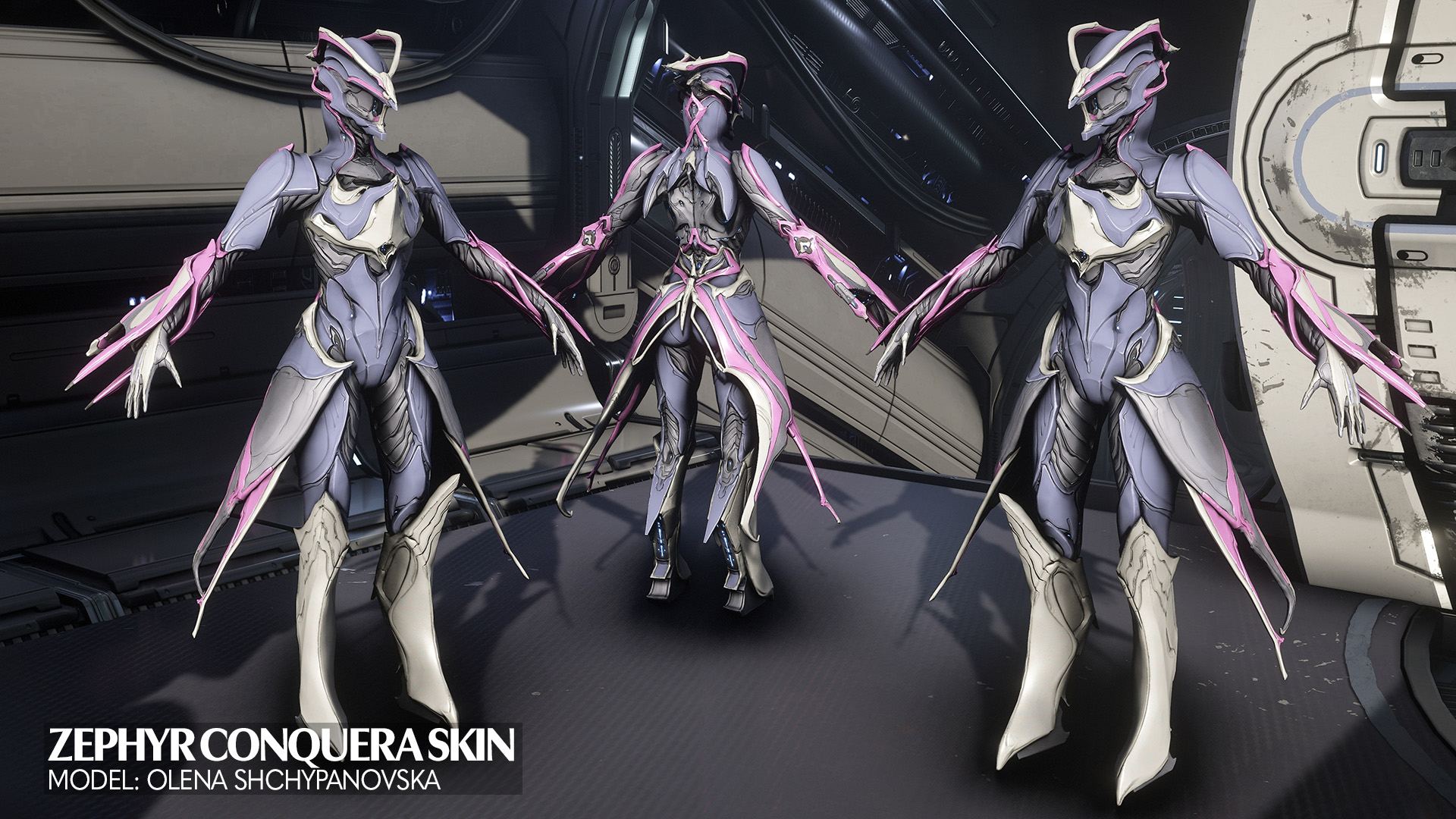
When I found out I’d be working on Zephyr’s Conquera skin, I’ll be honest: I was a bit nervous. This isn’t just another cool alt skin; it’s part of the Conquera line, created to support the fight against cancer. That kind of weight adds a different kind of responsibility and I really wanted to treat it with the care it deserved.
The concept itself was beautiful: full of graceful transitions and fluid lines. I’ve always loved designs that feel dynamic and sculptural, and this one had that perfect balance. My goal was to make Zephyr feel both flexible and regal, like she was floating, but still powerful.
Translating a concept into 3D is always a challenge full of unexpected surprises. Her legs in the 2D concept had a really nice flow in 3/4ths view: elegant and strong. But in the front view? They either looked weirdly pigeon-toed or like stiff little sticks. Finding the right balance took a lot of trial and error. We also had to work around how her legs would bend without creating awkward deformations and in the end we fixed the main hard element in place to keep the silhouette clean.
We added subtle touches too, like pink accents to tie her into the Conquera palette and gave her skirt a bit more volume and movement.
There’s always that magical stage of modeling when everything starts working from every angle, and you can finally just breathe and focus on details. It feels like meditation. And the best part? Watching rigging and animation bring it all to life. That moment when they take their first steps… pure magic.
Final Scaldra Concept
ARTIST: Michael Chomicki (Warframe Principal Concept Artist)
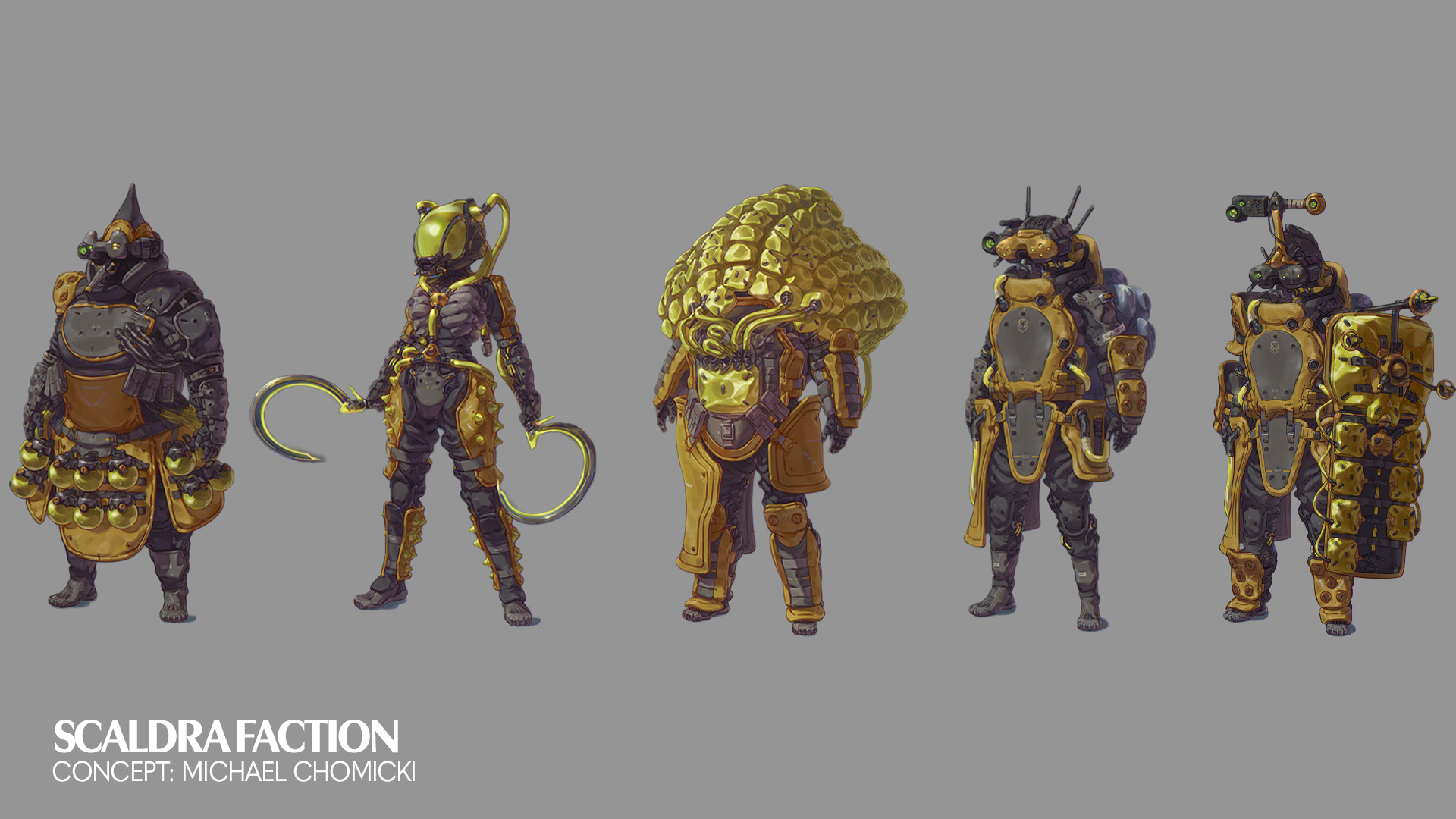
When exploring the design language for the Scaldra faction, the team asked themselves the following question: what would a normal soldier from an alternate reality, faced with the impending threat of extinction at the hands of a bio-tech weapon, look like?
A decision was made to use awkwardly-pieced together hazmat suits, featuring off-axis shapes and amusingly overemphasized volumes, in order to instill a grotesquely distorted and clumsy visual quality to the enemy units. Legibility during rapid, ranged engagements was another key sticking point during the design process, which led to the use of bright, liquid Enferon-filled bags, weapons and accessories, in order to give each trooper their own unique visual identity.
The Hex Mocap
ARTIST: Jason Walmsley (Warframe Principal Animator)
I was fortunate to be part of the MoCap and Animation teams that brought Hex Quest to life. This was an exciting and unique challenge: similar in some ways, yet very different from our usual Tenno animation work. Through the Protoframes, we aimed to showcase new personalities while staying rooted in the essence of the original Warframe characters.
It was a big responsibility to meet fan expectations, especially since many players have spent years mastering their favorite Warframes. We knew these characters meant more to players than just in-game avatars — they’re personal and deeply meaningful. That’s why we took the challenge of revealing a more human side to these characters very seriously. We focused on identifying each Warframe’s core traits and had a great time reimagining them in human form.
One of my favorite parts of working on Warframe is the variety of Warframes I get to animate. Exploring their human side added extra depth and dimension to their personalities. As we developed the Protoframes, we paid close attention to silhouette, props and contrast between the six featured characters. Before the Protoframes, our typical MoCap shoots emphasized physical acting. With the Protoframes, however, we introduced more narrative-driven performances, incorporating story and facial acting to bring them to life in a new way. Collaborating on their banter and interpersonal dynamics was incredibly fun and added even more personality. Through the combination of character design, voice acting, story and animation, we were proud to make a lasting impression at last year’s TennoCon.
Seeing the fan reactions was incredibly rewarding. Our whole team was thrilled with the outcome and we’re excited to share even more with the community. It’s hard to believe that after over 10+ years of Warframe, the team is still creating fresh and compelling content that honors the past while pushing boldly into the future.
Scytoid Model
ARTIST: Vladimir Veskov (Warframe Weapons Artist)
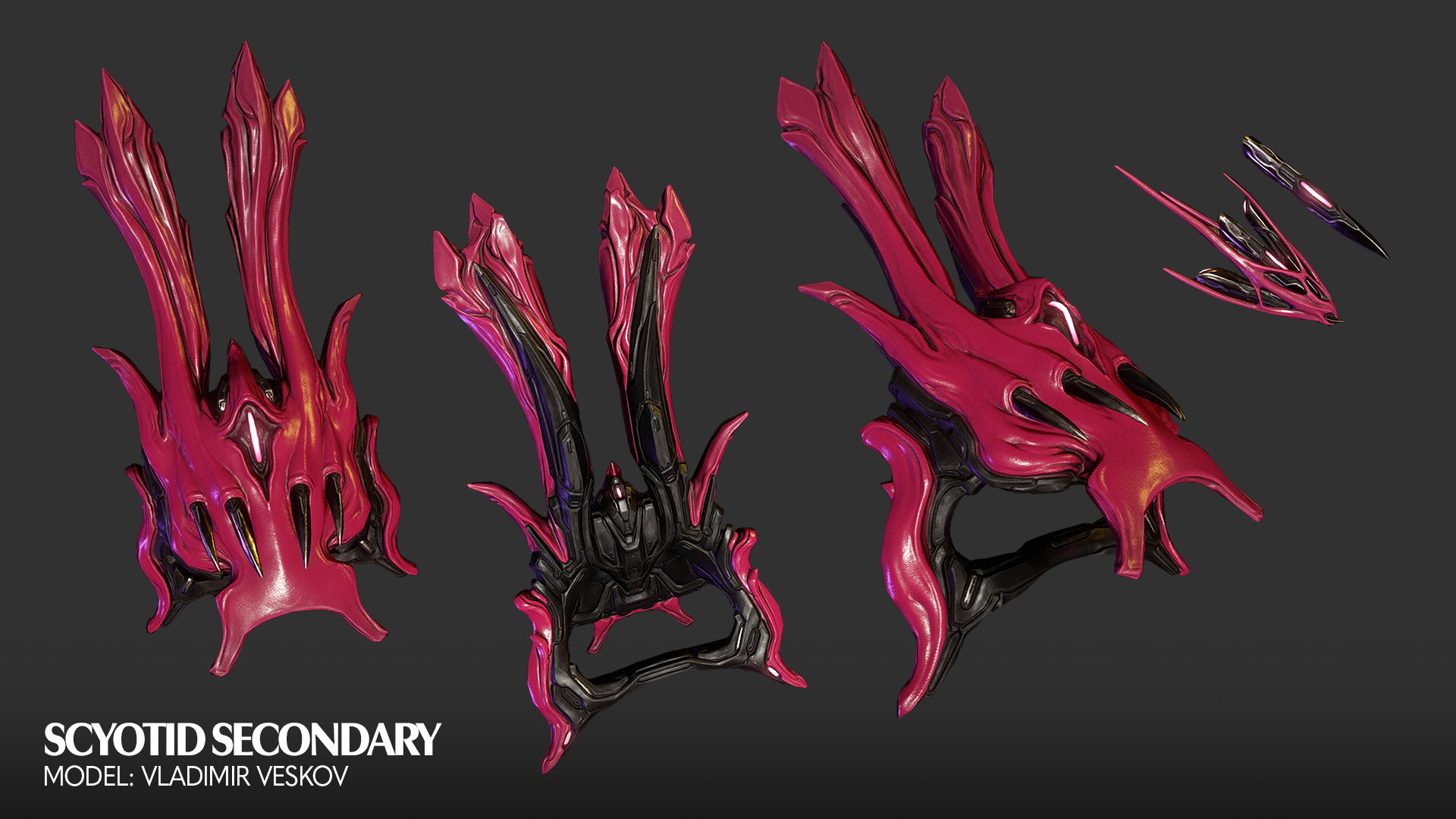
Working on this piece was challenging, but overall a very interesting and rewarding experience. I was tasked with making a new weapon for Oraxia, which would be a part of a set. The talented Kory Cromie provided the concept art and I wanted to create something that would combine the more traditional Warframe style with the great signature design of Oraxia done by Nikita Leshakov.
The Scytoid was intended to be a projectile weapon, even though it doesn't look like it. I was excited, because it was my first time working on such a weapon type, shared with only one other weapon. The process involved the blending of organic shapes and mechanical detail, keeping it elegant, but also "dangerous" looking.
Since it was spider-themed, I've also drawn some inspiration from real-life animal specimens: mostly the Spiny Orb-Weaver spiders. For the weapon functionality itself, I envisioned something between the Tekko, the metal claw weapon, and a wrist-mounted dart thrower with some webbing action thrown in, keeping with the spider theme. It's great being able to work on crazy weapon designs and then eventually see them fully-animated and in action!
I think the animation team — most notably Jessie Milne and Tim Sormin — outdid themselves with this one. And of course, the awesome webbing FX by Vincent Wedde really helped it come to life in all its creepy-crawly glory.
Coda Bassocyst & Dual Coda Torxica Models
ARTIST: Ernesto Alvarez (Warframe Senior Character Artist)
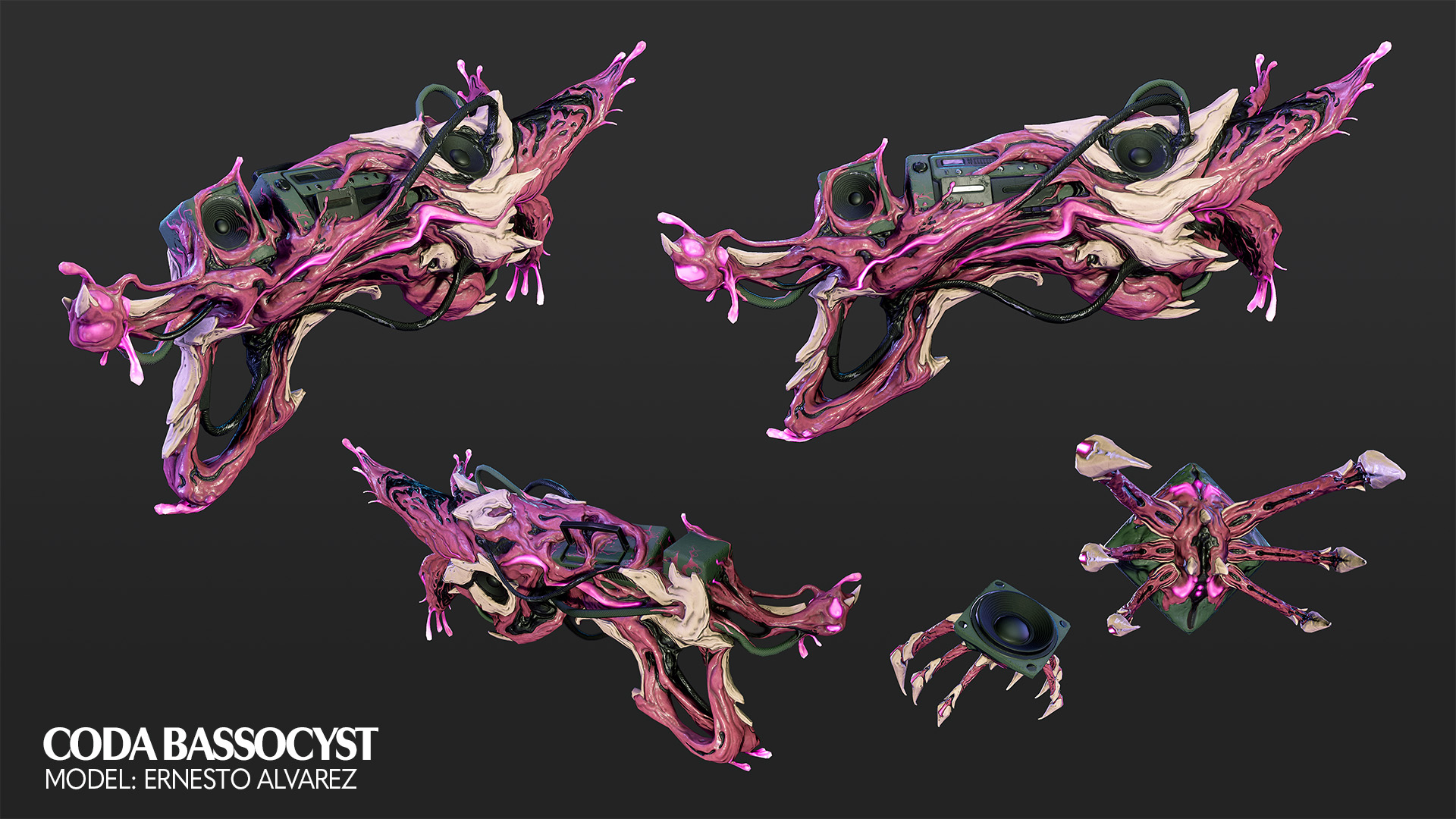
Warframe can be weird, but making weird things is not easy. Working on this weapon felt more like creating a living creature than designing an object. Some assets just take on a life of their own mid-production and this was definitely one of them.
Loaded with gnarly organic references — trust me, you don't want to see my moodboard — and the original concept by Sergei Demidov, I got to work sculpting and texturing what might be one of the wildest weapons I've made so far. The first weapon I created for the Techrot Encore update was the Dual Coda Torxica, a pair of dual-wielded pistols with a unique twist: it's actually a power drill taken over by the Infested. I jumped into the Bassocyst right after wrapping the Torxica, so I was already tuned into the vibe.
My sculpting workflow starts with a blockout in VR, which really helps nail the scale and form; especially for those fleshy, bony elements that need to feel gnarly, but also tactile. After that, I put together a rough version and added it into the game so other departments could begin their work. But that was just the beginning. It took several weeks of iteration to land on something that felt equally gross and awesome: fun to look at and fun to play with.
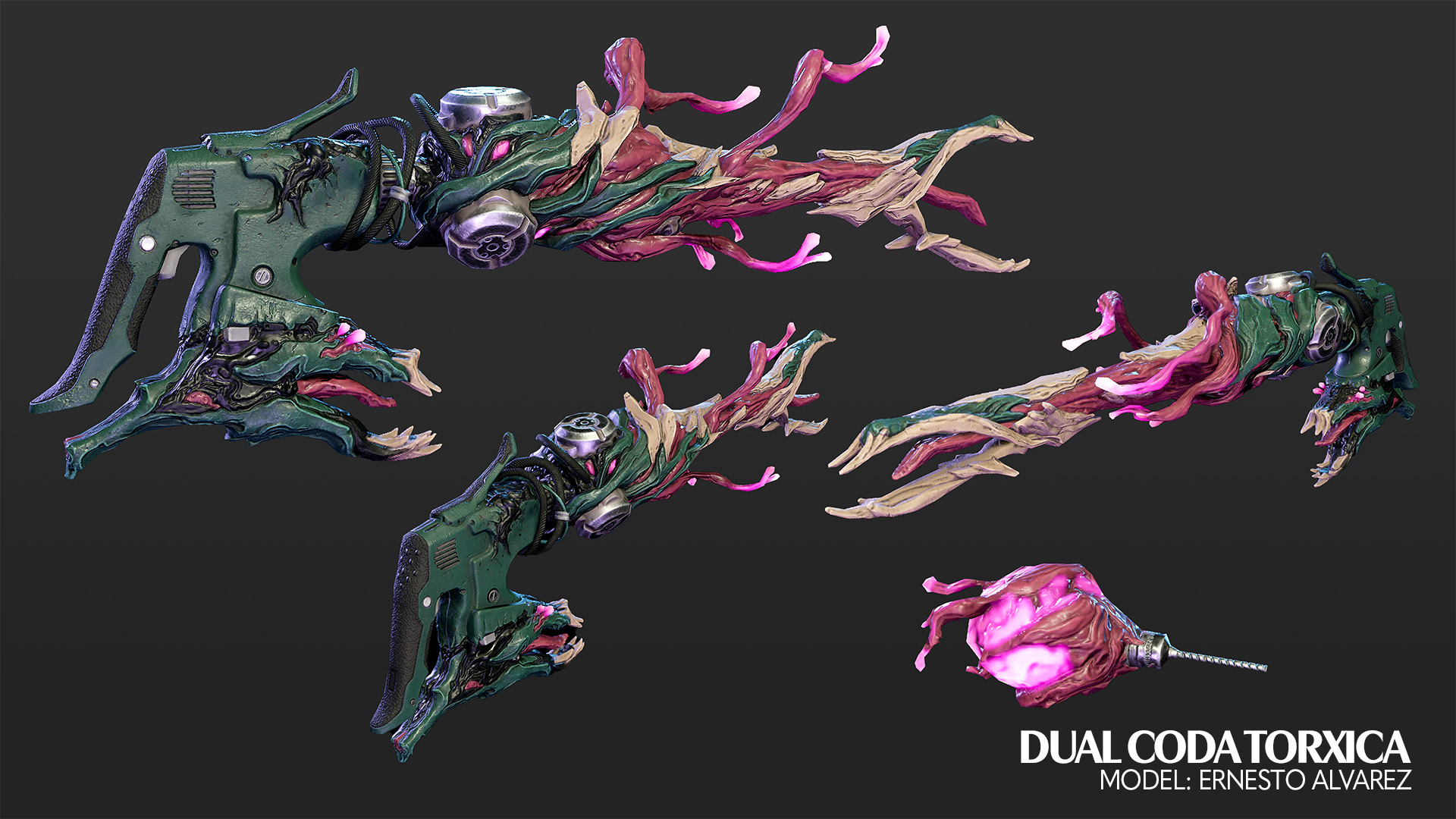
The big design challenge? Surface contrast. Techrot weapons live in this space between decay and function. The flesh needs to feel fleshy: wet, sagging, unpleasant. The bone needs to feel dense and solid. And then, because this is Warframe, we had to integrate a boombox in a way that didn't feel like it was just slapped on. It had to feel like something a Warframe could actually wield.
Throughout production, every department was excited to see the Bassocyst evolve. There's a certain energy when the whole team's hyped about a design. It turns into this shared creative push where everyone throws in ideas to make it weirder, cooler, and more fun to play with. In the end, we made something loud, alive, and a little bit disgusting. Which, honestly, is kind of the point.
Spinnerex Whip Model
ARTIST: Andrew Yu (Warframe Senior Weapon Artist)
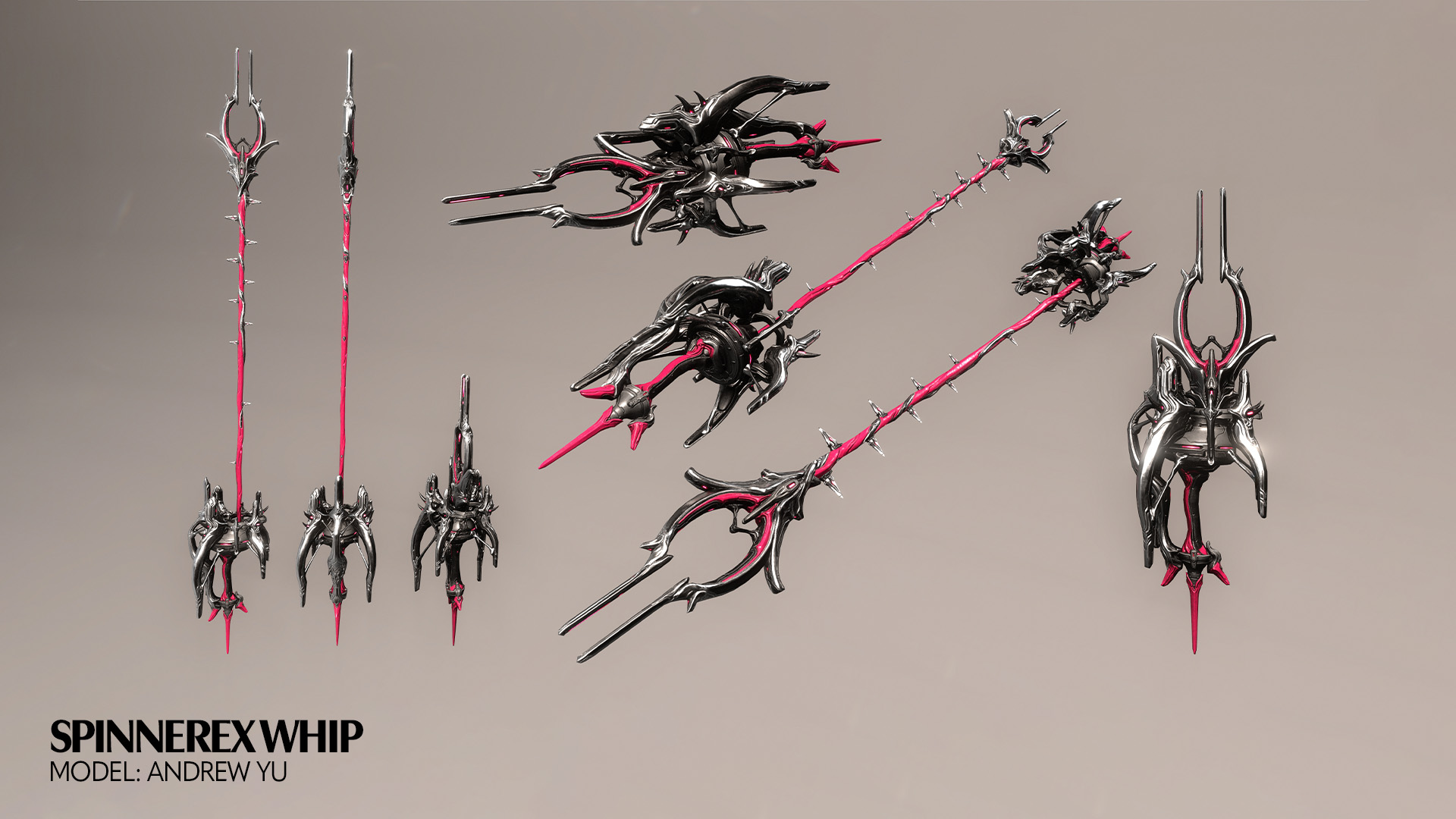
The initial idea was designed by Principal Weapon Artist Nikita Leshakov and polished by Principal Concept Artist Michael Chomicki and then passed on to me. I am honored to be in the Oraxia Bundle team and be able to bring this awesome melee weapon into the game.
The design of the Oraxia is so cool and this whip is one of her signature weapons. Therefore before I started working on the weapon, I took some time to study Oraxia. "Intimidating, but also elegant," were the feelings I got, along with the insect features: spikes, spider webs, exoskeleton, hair and spider legs. Those elements were something I wanted to add to the whip.
After getting approval, I applied the design language and overall feeling of Oraxia onto the whip. Finding a good balance is definitely the most challenging and fun part of making this weapon. I liked how it turned out and hope you like it as well!
Devil Warframe Concept
ARTIST: Sergei Demidov (Warframe Concept Artist)
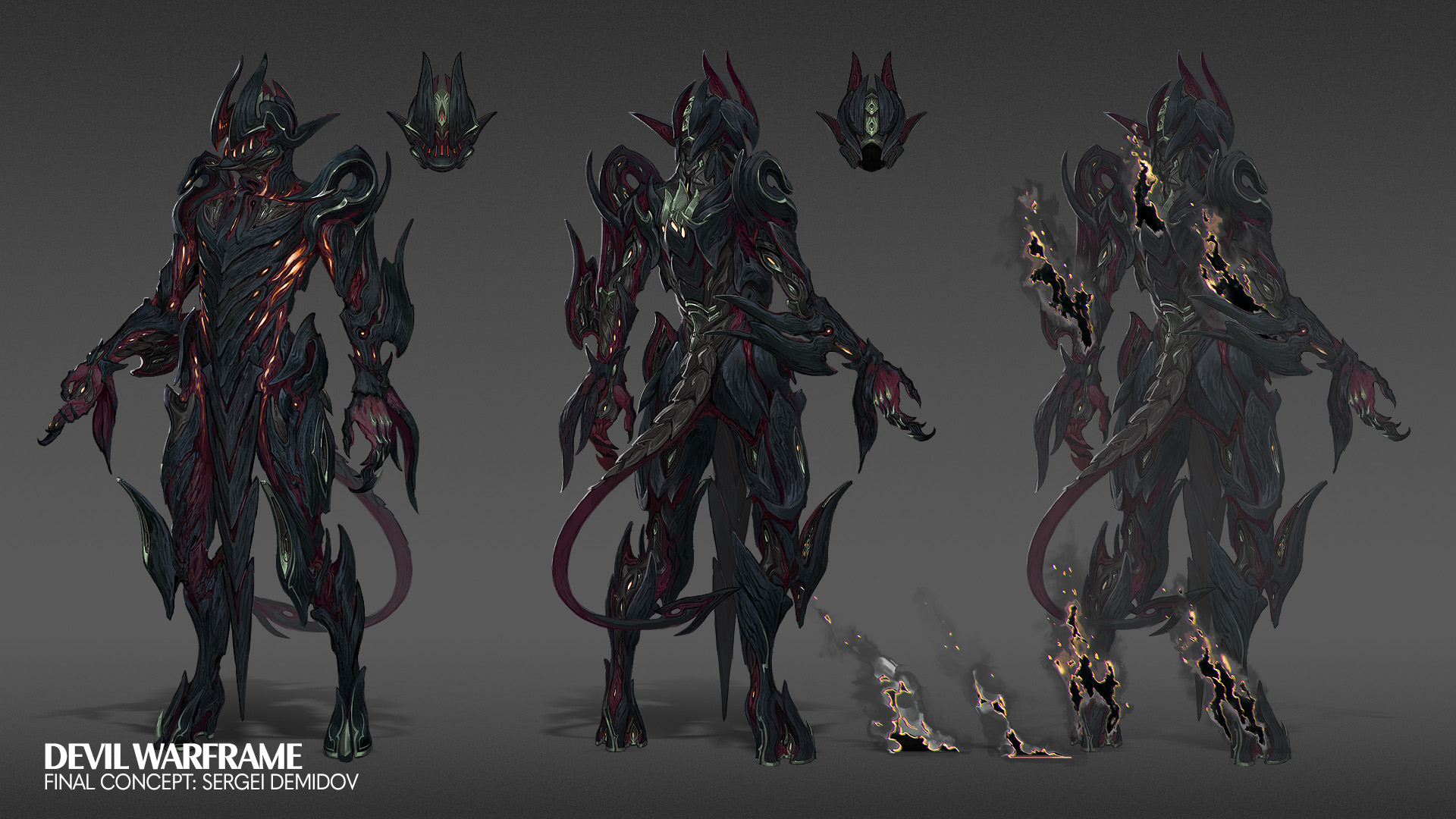
The original sketch for the Devil Warframe was made by Mike Brennan, the father of the Warframe art style, so when Eric Vedder told me I’d be finalizing the concept, I felt equally honored, humbled, excited and scared. The task looked very daunting to me, as a decade-long fan of Warframe and a relatively new team member.
The first goal was to interpret the side view and stay as faithful as possible to the original sketch while locking in the final design. It was fascinating to work through all the little design decisions of the sketch, especially the ones I didn't know what to make of at first, only to later realize they make perfect sense and are kind of neat. The backview gave me the most freedom, and I had a blast designing it, trying to find interesting shapes that work together well and make you enjoy staring at his back for hours straight. I am very grateful to Marco and Kary who helped me steer clear of some missteps and stay true to Warframe’s tech design language.
The color scheme went through a few rounds of iteration. The main theme settled into something Rebecca called "the black flame": imagine if the Balrog had a Warframe cousin. Black, crusted armourflesh plating over red, fleshy muscle, with fire bleeding through the cracks. The magical flame VFX for his abilities was also tricky to get right at first and here's where I owe a big thanks to Nikita for joining the discussion and pushing me towards attempting to make a literal black core work together with a glowing outline, creating a cool visualization of the black flame idea we had.
Another tricky bit was getting the metal armour parts right. Gold worked great there, but it's usually reserved for Prime variants as a default color, so I had to find another solution. I struggled with that for a while, until I came to the concept, kind of a scientific one, of using the color that shows up on steel when heated higher than 600°F or so. It sounded cool to me, at least.
It was a great honor to work on this task. I believe that together with the rest of the team, we managed to pull off something that Mike Brennan would like to see. And I hope players will enjoy his visuals and his kit that promises to be super fun and hopefully slightly OP.
Major Neci Rusalka Model
ARTIST: Mike Skyers (Warframe Principal Character Artist)
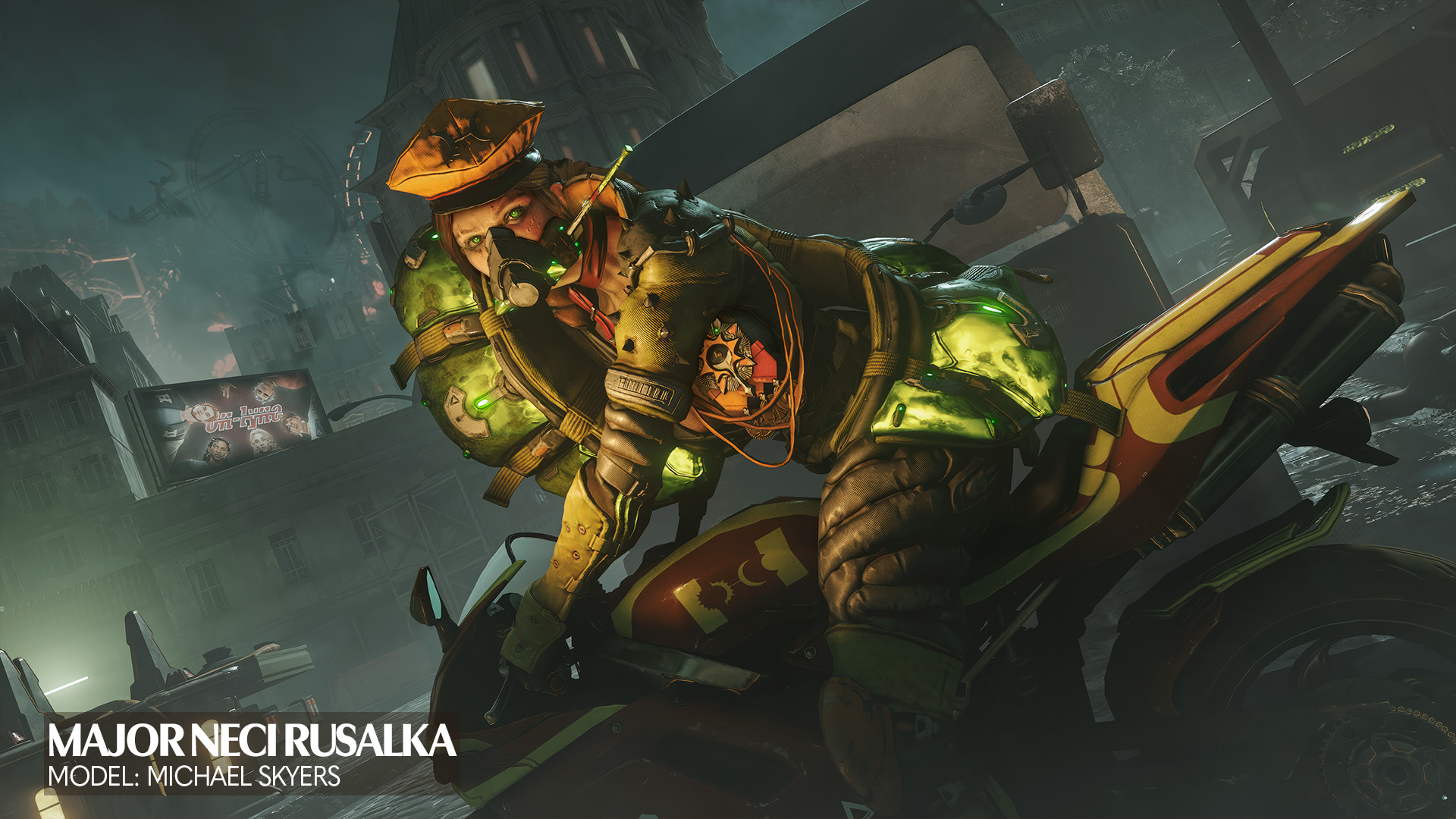
Major Neci Rusalka is easily one of the coolest characters I've worked on. Bringing the Major from 2D concept to the character you see in game was an exciting but also a nerve wracking experience. Having worked on Warframe for about 10 years I can count on one hand how many characters I've had to work on that had normal Human anatomy much less an actual face with eyes and stuff. As much as I love to design and sculpt Warframe skins, Liger once again created a really cool concept and it was hard for me to say no. On a good day, a Liger design is a complex thing to translate to 3D and the Major took the complexity to another level. There were definitely moments when I felt like a slug being crushed under the Major's heel, but no pain, no gain.
There were two fun challenges that left me feeling quite accomplished. The first was her Efervon Shawl. It's such a huge element of the character. It had to fit on the 3D model and feel visually balanced. Aside from her face the shawl was the thing I spent the most time on. There were a lot of elements to make. Then fitting them all together and wrapping them around her figure took some time and careful attention.
The second thing was braiding her hair. One of my team members pointed out that the name Rusalka was related to Slavic folklore involving a water spirit. So instead of doing simple straight hair, I pitched the idea to go with a mermaid-style braid. I didn't know what I was getting myself into. It took me a few online braiding tutorials and a lot of trial-and-error to figure out how to wrangle the polygons into place. In the end it was worth it and I can't imagine Rusalka any other way.
All that said, I think my favourite part of her design is her robotic claw arm. When the animations for her intro scene started rolling in and I saw her claw rack along the ground, tingles shot through my spine. I also love the way she walks: amazing. Not to mention the voice acting from Elsie Lovelock made feeling like a slug all worth it. Oh and I can't forget about the fan art. There are some absolutely incredible works out there and I can't get enough. More, please and thank you!
Oxaria Concepts and Model
ARTIST: Nikita Leshakov (Warframe Principal Weapons Artist)
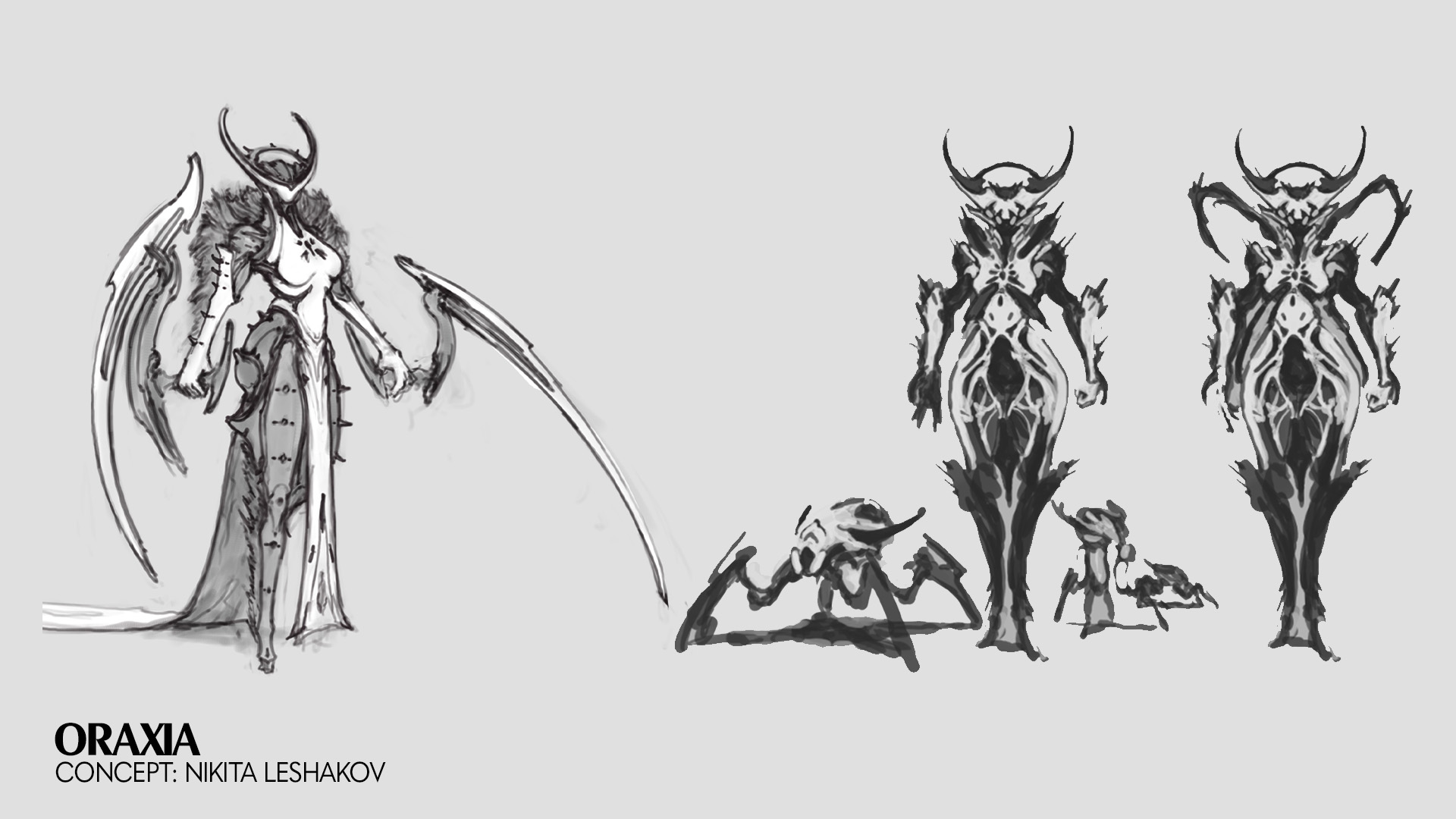
Oraxia took two years to make and in those two years I’ve had some deeply introspective experiences as an artist, one of which ended up influencing Oraxia’s final design. It was a complete rework from where I started, leaning more into seductive and titillating imagery.
The design of the head, the orb weaver spider inspiration, is the only thing that remained in some way, though I’ve altered and simplified it quite a lot. Everything else was first loosely airbrushed, then gradually sculpted from rough forms. Some in-game tests happened when the model was about as early as 20% done.
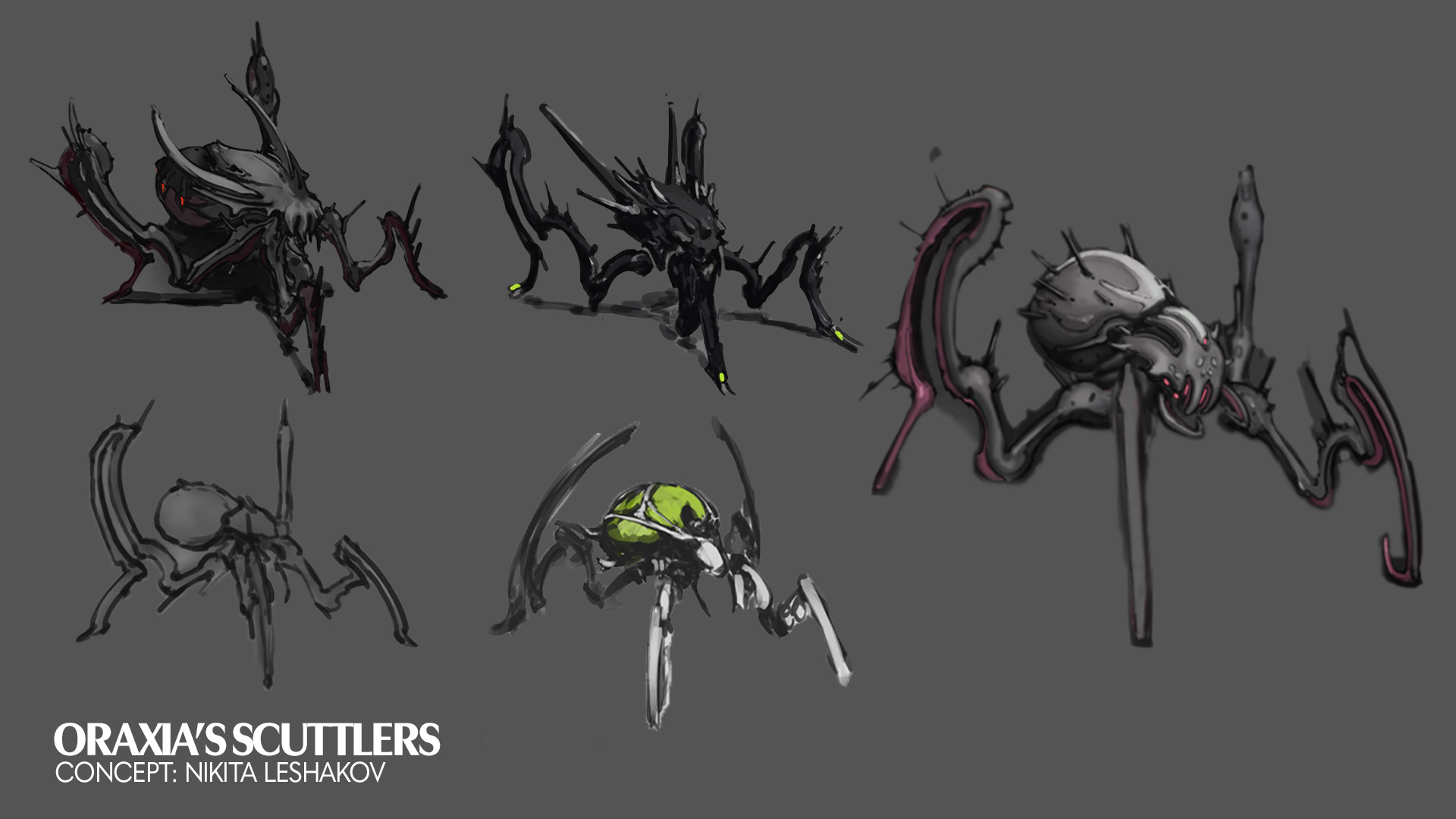
Art is about making lots of big and small choices over time, and part of the artistic skill is to learn how to implement those choices consistently and precisely. Since humans aren’t fixed in time, the quality of our work varies and having an inefficient workflow snowballs into more and more choices to make. Errors happen and compound, both oversights and overthinking stack up, and the piece ends up overworked. In small doses, this drift is healthy, and gives art an unmistakably human quality.
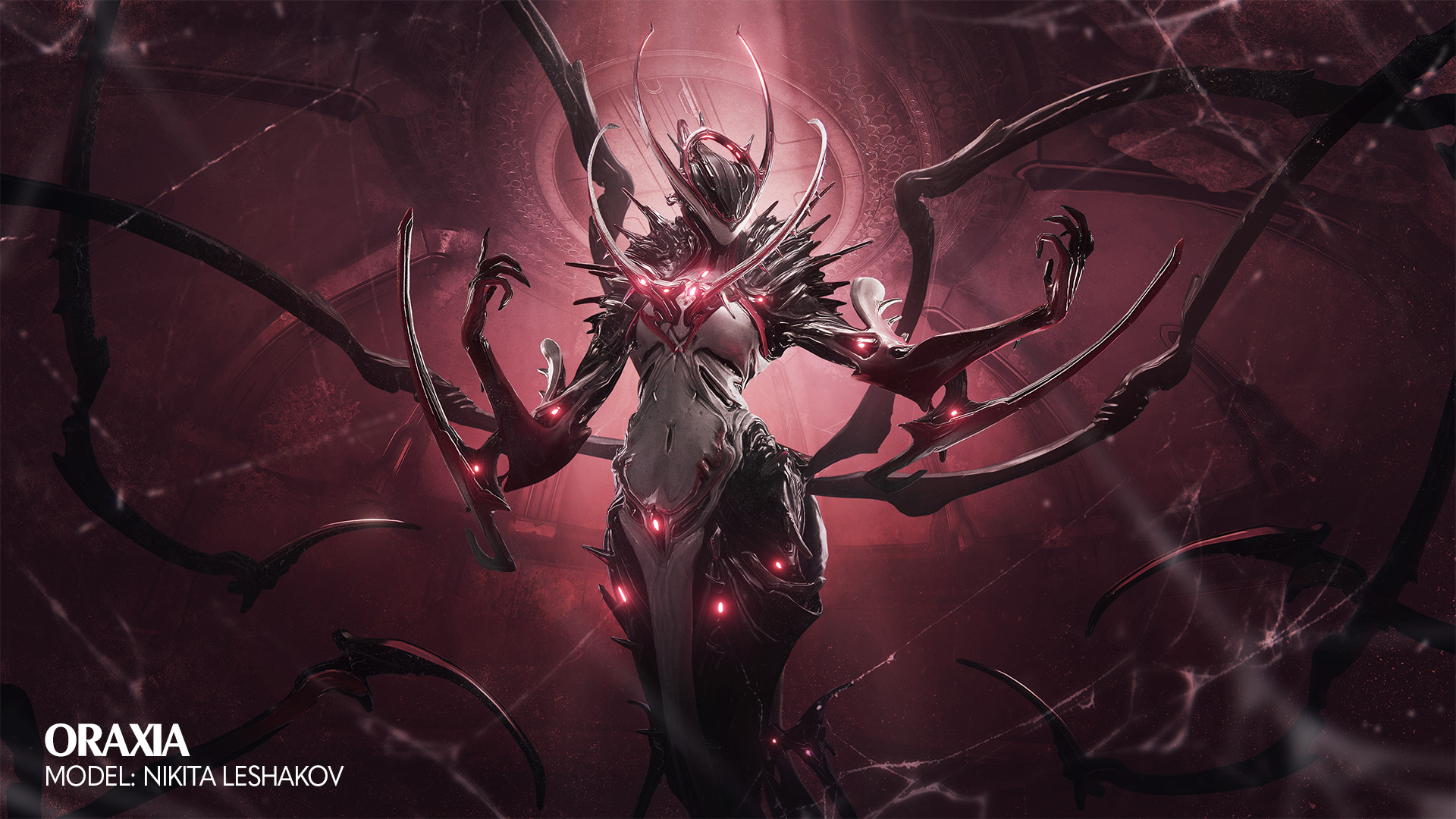
Oraxia’s process prioritized overall momentum versus breaking things down into strict steps and stages. I never made proper concept art; I didn’t even fully know the final look until I started improvising some of the details on the rough sculpt. I do not recommend working this way, but this is how I’ve developed as an artist. I sometimes end up tinkering with my art assets right up until they’re shipped.
H-09 Efervon Tank Model
ARTIST: Diogo Azambuja (Warframe Intermediate Environment Artist)
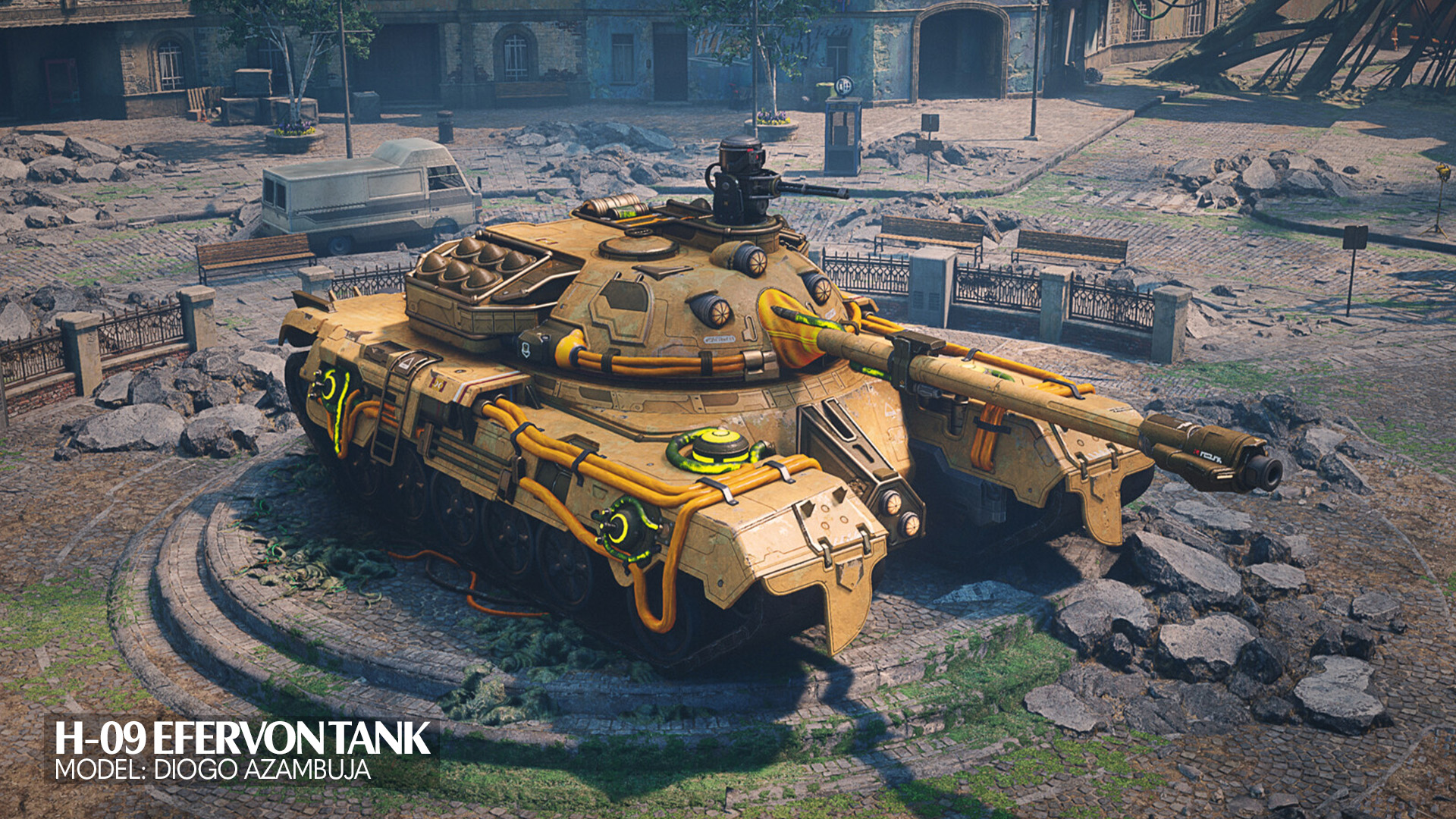
The H-09 Efervon Tank was an interesting and fun challenge from the start. Making a complex mesh with lots of moving parts that need to work independently all within our technical budget was definitely not easy and required the full cooperation between multiple sectors: 3D Art, Gameplay Design, Rigging and Programming.
The concepting stage for this boss fight was super fun, but with a lot of back and forth. What do we want it to look like? Do we go with a more realistic look and proportions, or do we exaggerate its silhouette? Do we want an agile and streamlined design, or something tall and expressive like the tank in Metal Slug?
Eventually, we had a few solid design options the team was happy with, but nothing was set in stone just yet because the boss arena and the fight itself were not fully-designed at that moment. Things were changing on a daily basis like how big the arena was, how many different abilities the tank would have, how the player is supposed to fight it and how the second phase would look. Because of that, I had to work not only quickly, but in a smart and reversible way because anything I did could be altered at any moment.
One key moment in the development cycle for this tank happened just three weeks before TennoCon 2024. The entire mechanic of getting a Rocket Launcher to destroy the tank was not part of the fight at all. Suddenly someone found an old model of an RPG in our files, decided to implement it into the game and shoot the tank with it just for fun. After sharing that video on Slack just as a meme, everyone's immediate response was "Wait a minute, that's actually really cool." And just like that it was turned into an official mechanic to that boss fight. The weapons team then had to quickly make a brand-new RPG model that fit the 1999 universe and the programming team did a great job making it work.
Bonus Art
